

































































































































































































Australia’s Indian community present tributes to industrialist and philanthropist Ratan Tata, who passed away on 9 Oct aged 86.
Mala Mehta OAM wrote: A man of dignity and honour. Om Shanti.
Manisha Belani wrote: His contributions to the business world and his unwavering commitment to philanthropy have left an indelible mark on society. May his soul rest in peace, and may his family and loved ones find strength during this difficult time. His wisdom and humility will be greatly missed.
Anu Shivaram wrote: An irreplaceable loss to the country. India has lost one of its greatest industrialists. A much-respected entrepreneur, a man of great dignity and integrity. Rest in peace, Sir.
Rani RJ wrote: May his onward journey be aboard the airline he resurrected. One of two Tatas who left as legends.
Tanu Bhatia wrote: It’s a big loss to the country.Well played in the match called life sir, you are a gem. You will always keep shining as a star and be an inspiration to all generations.
Sudesh Johar wrote: Ratan Tata lived in the world of riches but with utmost humility. He touched many hearts and transformed many lives. His legacy will remain evergreen.
Ashok Kumar Chandok wrote: A great loss for Indians. May God give peace to the departed soul.
Akki Gaurav wrote: Rest in peace, Ratan Tata Ji. We miss your unwavering love for India. You will stay in our hearts forever, andyour legacy will continue to inspire us. Ronica D'Cunha wrote: May his soul rest in peace and may light perpetual shine on him.
Dinsha Palkhiwala wrote: RIP. As a proud Tata employee and one who started his professional career in TCS, my deepest gratitude to a unique leader. One has to have worked in a Tata organisation to understand the work culture he created.
Rekha Kanth wrote: Om Shanti. May Bharat be blessed with many more such Anmol Ratans.
Menon Manoj wrote: RIP Ratan Tata. A visionary industrialist and a compassionate soul.
Padmini Sunderaj wrote: Farewell. Om Shanti.

We asked for your favourite lines from the iconic film Dilwale Dulhania Le Jayenge. Josel Jose wrote: Ja Simran, jee le apni zindagi
Omkar Palav wrote: Agar woh tumse pyaar karti hai, toh woh ek baar palat ke zaroor dekhegi. Palat… palat…
Mansi Kaushal and Dreaming Leo wrote: Bade bade deshon mai aisi choti choti baatein hoti rehti hain, senorita.
Rajeev Ramakar Tiwari wrote: I have seen DDLJ more than 40 times in Maratha Mandir. Betaji, hum unme se hain jo chand dekhte nahin, ghar le aate hain Raj Saneja wrote: Memma shemma.




We’re continuing to hear from you about LAKSHMI GANAPATHY’s cover feature in our Independence Day issue, in which she encouraged readers to share a culinary tribute to the motherland.
Celebrating 29 years and 27 Multicultural Media Awards
Fergus Black

invoke a lot of very specific experience. It's a cool counter to stereotyping. Kaushik of Namma Australia wrote: Thanks for asking us to be a part of this (exercise). I am very glad and honoured that we are recognised. I have always kept my (regard) high for media and personalities working for our home country. Ranjita Sharma wrote: Thank you (for this feature) – the contributions are all truly fantastic. I appreciate the effort and thoughtfulness you put into this - it’s great to see such thorough work.
Tanvi Mor wrote: Thank you Lakshmi Ganapathy and Indian Link for allowing me to express my sentiments about my state of Haryana in your featured article. Your cover story beautifully highlights the rich diversity of India. Yes, I realise it’s just a brief piece, but every time we’re invited to participate in such initiatives, it gives us a sense of belonging and reconnects us with our roots.
PS: Loved reading everybody else’s contribution!
Preeti Thadani wrote: Thank you Rajni Luthra and Lakshmi Ganapathy for the opportunity to contribute to the August issue. I really enjoyed reminiscing about the flavours that reminded me most about Bombay where I was born and lived for the first eight years of my life. No matter which food or country, tastes conjure up so many memories, and India is one big smorgasbord of delectable delights. Well done on selecting a universal theme to pair with Indian Independence Day. Khagesh Maheshwari wrote: Indian Link is a good Indian paper, and Lakshmi seems to have very good quality writing talent, so it was a pleasure to read her article!
Zenobia Aderbehman wrote: Lakshmi, it was a pleasure to participate and write about what's closest to my heart i.e. Indian cuisine. No matter where in the world I am, I crave for Indian food.
Glen D’Souza wrote: Every time I go to an Indian restaurant and order a fish curry, memories of Mum’s cooking takes over. India tastes like the fish curry Mum used to make, cooked in an earthernware pot on a real fire.
Ash Meaney wrote: Thanks Lakshmi, now I’m starving.
We asked, why is Abhishek Bachchan sitting in Ajay Devgn's lap?
Arora Vicky wrote: Abhishek is 2 years old.
Digvijay Soni wrote: A brother in need is a sister indeed!!
Omkar Palav wrote: He just got born.
Sumeet Singh Chhabra wrote: It’s Dostana time.
Augustine Jiljilmary wrote: He wants some Meesha Paan

Rekha Kanth wrote: Maine kuch nahin kiya Ajay bhai, Kajol se poochcho
Pavneet Kaur wrote: Because Maa da laadla bigad gaya.
Sanjay Khanna wrote: Kyunki woh bahut B(h)ol(a) Bachcha(n) hai!






CAMPBELL WILSON, CEO and MD of Air India, shared his vision for the fastest growing airline in the world, with PAWAN LUTHRA
Stuart Ayers wrote: So much opportunity for Air India, and Campbell Wilson is bang on target when it comes to need to improve the product.
Rahul Gupta wrote: Very good Pawan. Hopefully, the proposed developments with Vistara and Singapore Airlines will put Air India back on the radar (no pun intended) for serious travellers. At the moment, the horror stories from real travellers mean that it is simply not a serious option. As the CEO says, people of Indian heritage want to support the national airline but caveat emptor!!
Harry Lagad wrote: 2026 to fix a few broken seats and entertainment units for flights to Sydney from India! Must be a joke! If an airline wants to fix things it should happen in months.
Mahesh Enjeti wrote: Thanks Pawan for giving us a window seat to witness Air India's onward journey. An informative and illuminating interview.
Selwyn D’Souza wrote: A great interview Pawan and kudos to Campbell Wilson.
Chary Chigurala wrote: Excellent interview and great insights.
Pawan Luthra wrote: There are only 28 expat CEOs in India, and one can see why Air India Limited CEO and MD Campbell Wilson is one of them. His passion for the job is clear in this interview. And yes, he has promised to fix the broken seats and the non-entertaining entertainment systems on all Australia-India flights by end 2026. I believe him.
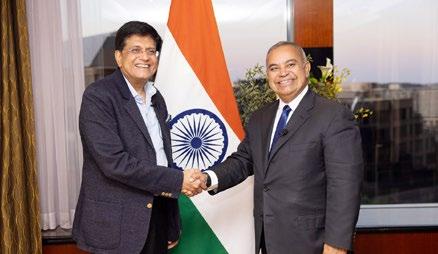
PIYUSH GOYAL, India’s Minister of Commerce and Industry, talks to Pawan Luthra about the state of India’s economy, and the state of the trade relationship with Australia
Jagjit S wrote: Establishing a dedicated office for tourism and trade in Australia is a promising step towards enhancing collaboration and investment opportunities between our nations.
Danny Singh wrote: Jai Hind and keep growing, Bhaarat. Please reward those beautiful brothers and sisters who worked tirelessly and did India proud with their duty, and our fauji veer (servicemen).
Raja G wrote: The blueprint for a successful trade negotiation is that the net investor country should get a 0% (or close) net duties from the recipient country for a period of 15-odd years. If future investments match or exceed duty revenue, the trade regime can continue indefinitely. Hopefully, India and Australia (and also the UK) can have such an agreement
Jai Patel wrote: Very nicely done, Pawan Luthra.
Surbhit Dhanji wrote: Thanks for sharing.


‘I’M INTERESTED IN STORIES THAT PUSH DIVERSITY FORWARD, BUT
DON’T NECESSARILY HAVE TO HAVE RACE DISCUSSED’
Raj Labade, Indian origin actor who stars in The Office (Australia) speaks with MANAN LUTHRA about work, juggling identities, and diversity on screen
Nisha Labade wrote: Well, well, well little brother! Very proud of my lifetime partner in crime doing his bit for the Indian diaspora.
Tiffany Wu wrote: Wow, congrats to Raj!
Dr Jaspreet Saini wrote: Love this - a great way to demonstrate and celebrate diversity. Congratulations Raj, and all the best.
Kunal Bordia wrote: I didn’t know of Raj Labade before I read this piece. He speaks with wisdom beyond his years – I wish him much success as an actor.
This mausoleum is an example of Euro-Indo-Islamic architecture, with French windows and Gothic columns, minarets with spiral stairs, and silver inner doors. Where in India is it?


Standing at 15.2 metres tall, this massive statue pays tribute to Australia’s wool industry, modelled after a famous local ram. Where in Oz does this iconic giant reside?
Kaur,


























BY LAKSHMI GANAPATHY
The bright lights of Diwali (also known as Deepavali) are here, bringing warmth, festivities and love. Regardless of what denomination you are, or language you speak, Diwali is a time to come together and discover the light and joy in the people, places and things around us. This year, we asked the community to tell us what lights up their life; from family and friends to volunteering and travelling, there’s so much in this world that we continue to find solace in, and which invigorates us through the darkest of days.



and
is

like when old. The children will keep down generations. Children innocent, carefree and happy enjoy the Deepavali most. me of my childhood enjoying sweets and firecrackers and Deepavali without feeling anything in the world.
NIDHI PANICKER

I find light in the mundane reality - the frantic trip to the airport, checking of travel documents, the thatdelusional I inupgrademight counter well, and andinternationalthe their out-of-budget shopping laneways. These small moments, for me, enhance joy I feel when I go overseas over finishing that intense hike, finding hawker food in the tiniest of alleys, a conversation with a local in their
ANU SHIVARAM

I find light in reaching out to people in need, especially children. I work for a charity called Vision 2020. Around Diwali every year, look for organisationsdeserving in India and help them with funds we raise. This year we are supporting an orphanage with school-age children. I sleep well at night thinking my efforts might have contributed a tiny bit to provide nutritious food for a child or buy them schoolbooks. This gives more joy than anything we do for ourselves - try it! Alone, we may not achieve much; collectively we can light up many lives.

SAJEEV I find light in my grandparents. My grandmother taught me being strong doesn’t necessarily mean being stern or defensive, and to be kind even when it’s difficult (and I’m sure that I gave her many difficult moments). My grandpa’s positivity has not declined with age. He is sure I will achieve whatever I set my mind to, regardless of any setbacks or failures I experience. I look forward to evening phone calls with them, where we talk about anything from university, friendships, to the latest scandal in whatever soap opera my grandma happens to be watching.

GUPTA
children! I see the future passing on good things to lighting up the rows of lamps for Deepavali! Their minds are like clean slates, and we can print whatever we want so they can illuminate the universe like string of lights when they grow keep passing good Children are the most happy humans and most. They remind enjoying new clothes, and sparklers on feeling bothered about


I find light in community service, because it connects me with something greater than myself, igniting a deeper sense of purpose. connectingWhether with the local volunteeringcommunity, for a cause or helping someone in need, these moments bring warmth and meaning to my life. This passion led me to host events centered on community engagement, start ‘Remove Blindfolds’, a social project addressing homelessness, and serve the public as a Justice of the Peace. Diwali, the festival of lights, symbolises hope, reminding me that even the smallest gesture can make a profound difference, brightening lives and fostering peace for everyone.

I find light in old photographs, retro Hindi Bollywood songs and chatting with old friends. The whole family smiles together in old photos without filters, not for social media. Celebrating every festival together with family and neighbours brings light into my life, because ‘Old is Gold’ and gold shines forever.

I find light in getting phone and video calls from my children and grandchildren. They are a very precious part of my day and week. They give me a lot of joy, comfort and happiness. I wait for their calls, and they instantly change how I feel about my day and life. My husband and I live far from our family and the main contact is on the phone. I am very thankful to God for my precious family.

I find light in my son! He brightens our home and lives and fills it with joy every single day with his boundless energy and infectious cheer. Watching him grow is bittersweet— from a tiny human who could barely walk to a young boy full of kindness, chivalry, and warmth that he so freely shares with those around him. It’s truly magical to see fragments of our personalities reflected in him, as he blends his own unique character with the habits and traits he’s inherited from us.

I find light in the warmth of community and shared celebration. As a Sri Lankan born in Australia, I’ve always admired Indian culture and cinema, and Diwali holds a special place in my heart. Celebrating with my Indian friends or at my Bollywood dance school, the festival becomes a joyful blend of love, light, and colour. Attending events like the Premier’s Diwali in Melbourne has deepened my appreciation for these vibrant traditions, reminding me of the beauty in diversity and the power of community. For me, Diwali is about sharing light and the connections that brighten our lives.


GOGOI
I find light in my family and their happiness. I am a new mummy in town with my second child. Every time I watch my children and their giggles, smiles and laughter, it makes my day worthwhile. The sheer pleasure of having them around me during festivals makes it all special. Cooking their favourite dishes, surprising them with gifts, planning for a holiday together and spending time with them; these small moments of joy where I can see the satisfaction and sparkle in their eyes lights me up. I can’t wait to celebrate this Diwali with my loved ones. reality of travel airport, the constant documents, indulging in delusional fantasy might get an at the check- counter if I dress the magic of international airports out-of-budget laneways. enhance the Diwali; the best alleys, or language.having people Aroundfor year, we deserving India with the This supporting children. provide Alone,

I find light in discovering different parts of the world. This inner urge of mine inspires me to see through my own eyes things that I have only read, heard about, or seen photographs. I can’t explain the extent of bliss I sensed when touched the exact location in Bethlehem, Palestine where Jesus was born, stood under the same tree in Bodh Gaya, India where Buddha meditated 2500 years ago, got splashed by the gushing waters of Victoria Falls, Zimbabwe, viewed Paris from the top of Eiffel Tower or unfolded reasons for human sacrifice in ancient Mexico. To share that light with others, travel writing has become my passion.


I find light in my partner Maria. For the last four years, he’s been helping me pick up the pieces and fix parts of me that he didn’t break. We’re not the perfect couple but I find profoundlymyselfconfident that he’ll treat me like I’ve always deserved even when he can’t or shouldn’t. His laugh is my favourite sound in the world and his voice melts the day’s troubles away. He came into my life when I needed love the most and never left. He is what lights up my life.

I find light in kittens! I’m allergic to them, but I love watching all kinds of kitten videos on Instagram – kitten feeding, memes, home videos of kittens falling off things. They’re so tiny and innocent – they remind me life doesn’t have to be serious all the time, and to look around once in a while. I aspire to be as carefree as they are, just sleeping, eating and stretching all day. Orange kittens are my favourite, always walking into things – very relatable!

I find light in my dog Benji. He is the most well-mannered and affectionate dog you will ever meet and is always there when you need him. I love everything about him - his woolly coat, his playful nature, the weird way he sits on his couch, his big smile when we come home, his love of forever chasing rabbits he will never catch. Going on walks with him are the most peaceful times of my day, when I can disconnect from the world and focus on myself and him. I am so thankful to have him lighting up my life!
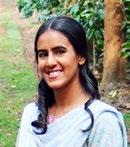
I find light within my friends. I cherish all of the time we spend together. Each smile, laugh and hug reminds me of the importance of human connection and shared experiences. I admire their beautiful qualities and ability to be vulnerable. When I’m in times of struggle, their genuine kindness and love help me find perspective, encouraging me to embrace my own strengths. I feel an immediate sense of safety and comfort in their presence. We support each other unconditionally, and I’ve learnt so much from them over the years. Happy Diwali to my beautiful friends who light up my life.

I find light in the fun we create as a family, in the lively singalongs, hands sticky from making and the mess of craft supplies scattered as we decorate together for Diwali. It’s in the shared joy of creating something special—be it a sweet treat, a colourful rangoli, or simply memories that last. Each year, our Diwali is filled with laughter, music, and creativity, with every little moment reminding me of how precious these times together are. The brightest light is the happiness we share, celebrating the festival with our own joyful traditions and endless love.

BY KHUSHEE GUPTA



As a young kid, I’m really happy because I’ve learned so much about Diwali, and it’s such a cool festival!
It’s called the Festival of Light, and it's really important in both Hinduism and Sikhism. In Hinduism, people celebrate Diwali because Shri Ram Chandra Ji came back to Ayodhya after defeating Ravana. In

Diwali time for me growing up was always right in the middle of end of year exams. Now that I’m all done with that time in my life, I’m glad to not relate Diwali with impending assignment deadlines and late-night study sessions. Sadly,

Growing up, Diwali for me meant spending quality time with the whole family. Papa would bring home crackers for us and us three brothers would enjoy bursting them at night. We also ate lots of jalebi and pakoras. After moving to



festival that comes around every year, signalling cashstrapped envelopes and mum’s scrumptious food. Last year, when my sister flew to the US for her graduation trip, our house suddenly felt empty. The joys of a home cooked meal or praying in front of a Hindu deity, everyday occurrences, felt more important now that I was involved in them. As I drifted to sleep that Diwali night, I felt content, simply because I had experienced adulthood for a day and I couldn’t wait for more. As I go over Year 12 preparation which sadly consists of stationery lists and paranoid textbook readings, I look back with a smile on my face thinking of what life could be like after school and how I can be more involved in all our special celebrations.


old living in Sydney, away from family in India, is a mix of nostalgia and adaptation. The usual buzz of family gatherings, sweets, and vibrant celebrations is replaced by video calls and solo rituals. The streets may not be lit with the same fervour, but I have to
create my own little Diwali at home, lighting diyas and cooking traditional dishes. The vibrant Indian community in Harris Park offers some solace with cultural events, but the distance from loved ones is felt deeply. Amid the festive lights, there's a quiet longing for the warmth of home and the closeness of family. Totally miss it!!
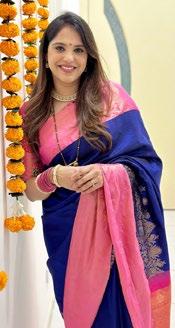
always held a special place in my heart. As a child, I would wake up at 6 with my brother and sister to burst firecrackers, while my mum made delicious sweets. We wore new clothes and visited family, and those memories are still vivid. Now, as a wife and mother of a 3-year-old, and celebrating Diwali in Australia, it feels both different and the same. While the celebrations have evolved, the emotions remain unchanged. I now follow the same rituals with my son that I once shared with my parents, ensuring he experiences the same joy and traditions that shaped my childhood.



SHAMMA SHARMA, 42, MELBOURNE

Celebrating Diwali has transformed significantly for us over the years. Growing up in Chandigarh, the festival was a vibrant affair, filled with family gatherings, colourful decorations, and neighbourhood fireworks that lit up the night sky. The joy of dressing in new clothes and sharing sweets with friends created lasting memories for both of us. After spending two years in Singapore, we experienced a rich blend of cultures that deepened our understanding


Over the years, Diwali celebrations have changed significantly. When I was a child, we celebrated in a more traditional, community-centric way. Preparations began a month in advance, with the family thoroughly cleaning the house. We lit clay and candles, set off firecrackers,


Diwali is one of the cherished times of the year when our extended family gathers to celebrate not only


meaning for me as life has progressed.
Growing up in India, it was all about the energy and excitement – the streets buzzing with people, the crackle of fireworks in the air, and families coming together to celebrate. I remember the thrill of helping my parents decorate the house, lighting diyas, and wearing new clothes to mark the occasion. Now, living in Melbourne for almost a decade, Diwali feels more reflective. It’s not just about the outward celebrations anymore. With work and life taking over, I’ve come to appreciate the quieter side of the festival. My wife and I still try to keep some of the traditions alive – cooking the same dishes we grew up with and lighting diyas in the evening – but it's more about finding joy in those small, meaningful rituals. Diwali has become less about the noise and more about the connection to our roots, and to each other.


transformed beautifully for me over the years, mirroring the rich tapestry of my life. As a child, it was a magical time filled with the warmth of family - cleaning our home until it sparkled, exchanging thoughtful gifts, lighting sparklers and indulging in a feast. Moving to Sydney after marriage, I found joy in the camaraderie of the Indian community, where we hosted lively dinner parties filled with laughter, delicious food, and spirited games. As my daughters grew up, their lovely dance performances at Diwali functions added a new layer of celebration, showcasing our culture’s vibrancy. Now, as we gather with extended family in Sydney, our home transforms into a festive haven adorned with lights and sweets, echoing the love and traditions passed down through generations. This year promises to be extraordinary as I celebrate Diwali in India, immersing myself in the very essence of my heritage.

for me, especially growing up in a big family with my four younger siblings. We would light diyas, share sweets, and make endless rangolis. My mother was the heart of our Diwali, her presence filled the house with warmth. But after she recently passed, things changed. My siblings all have families of their own, and Diwali has taken on a quieter tone for me. In my younger days, Diwali was all about the energy of preparation - decorating the house, helping in the kitchen, and the excitement of the fireworks. But now, at 62, I find myself enjoying the simplicity of lighting a diya, reflecting on old memories, and feeling the presence of those no longer with us. The celebrations in India have also changed - it's become more about the quieter moments, like watching the kids enjoy what we once did, and less about the grand festivities. Age has made me appreciate these quieter, more reflective Diwalis.
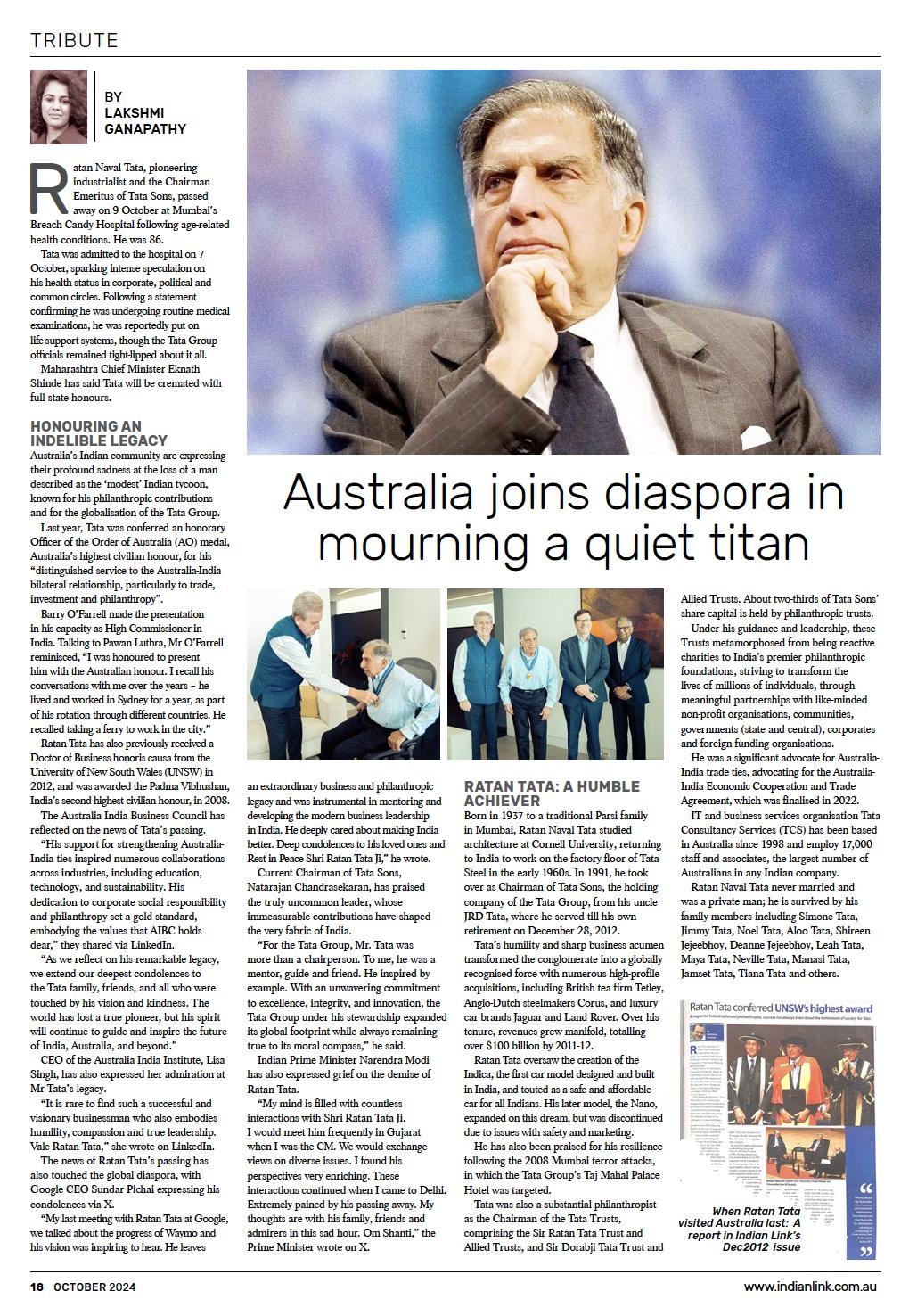

Ma hindra & Mahindra Ltd., a global leader in the automotive industry, announces the launch of its Black Edition XUV700 in Australia. Priced from AUD $43,990 driveaway, this special edition, offers a bold new look and enhanced luxury features, further elevating the XUV700's premium SUV experience.

The Black Edition not only boosts the luxury quotient but also includes exclusive features such asa blacked-out grille, 18-inch black alloys, black interior trim with Piano black finish on IP Doors & console, ventilated front seats with active cooling, and a memory ORVM linked for added convenience.


KEY FEATURES OF THE BLACK EDITION XUV700:
The Black Edition XUV700 introduces a bold new design with Napoli Black Paint that is complemented by a sleek, blacked-out grille and side trims. The exclusivity continues inside with a full Black Interior Trim, featuring a black dashboard, luxurious black seats in a 7-seat configuration, Dark chrome plating on AC vent, Door handles & steering wheels, Piano black finish on IP Doors & console along with ventilated front seats with active cooling to ensure ultimate comfort. For enhanced driving convenience, the memory-linked ORVM adjusts to the driver’s seat position with just a touch, and the Black18-inch alloys add a striking presence on the road. In terms of technology, the Black Edition is equipped with Wireless Apple CarPlay, Android Auto, providing seamless connectivity and charging options.
PERFORMANCE & TECHNOLOGY:
The Black Edition XUV700 comes powered by Mahindra’s 2.0 L mStallion turbo-petrol with Direct injection engine, producing 149.2 kW of power and 380 Nm of torque, mated to a 6-speed automatic transmission. The vehicle offers class-leading comfort with its SkyRoof™, spanning 1.3 metres, along with a dual 10.25-inch Super Screen for infotainment and cluster information. The XUV700 Black Edition is equipped with Mahindra's Advanced Driver Assistance Systems (ADAS), including features like Adaptive Cruise Control and a 360-degree camera setup.




You
Nurture
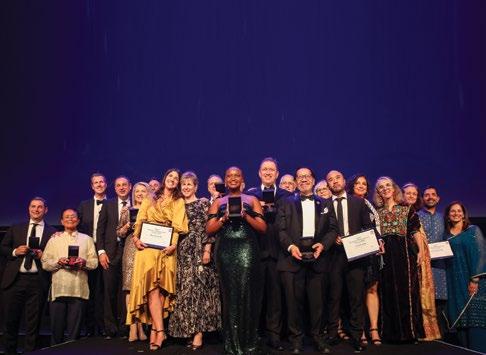








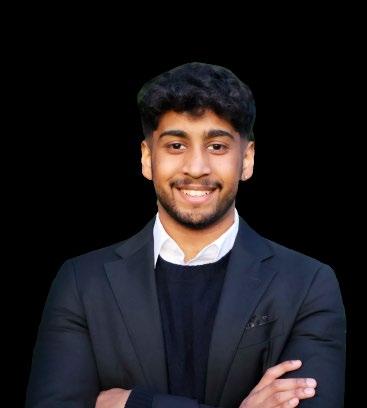

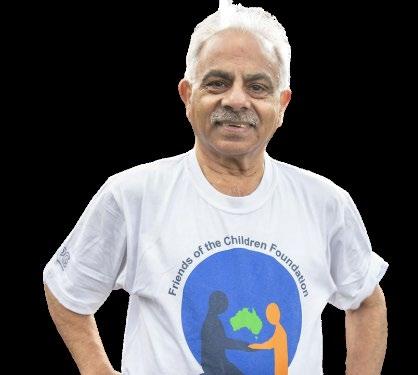

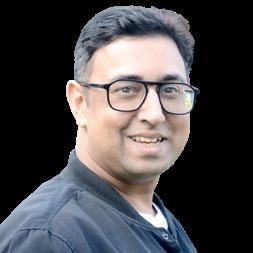



Victorian LGA elections: I made a list of every South Asian candidate in the state’s 79 local council areas - here’s what I learned.

IBY LAKSHMI GANAPATHY
t’s time again for Victorians in 79 LGAs to elect representatives, and it’s already shaping up to be a changeabout.
Except for those within the Moira Shire Council area (who were sacked due to the murder of a council worker, but that’s another story!), over the next four weeks, Victorians will head to the mailbox instead of the polling station, to enter a postal vote before Friday October 25, making campaigning more of a drip-feed than a gush towards the finish line. Ever the high-achievers, South Asians are turning out in a big way as candidates and following the trend of running independent which we saw at the NSW LGA elections – of the 181 South Asian candidates this year, a staggering 168 are running as independents. But what’s most interesting is how absolutely the major parties have been spurned; most party endorsed South Asian candidates are running under the Victorian Greens and Victorian Socialists, with a measly four ALP endorsed South Asians across just Merri-bek and Whittlesea. Even Darebin’s perennial Greens candidate Alex Bhathal is flying solo this year.
The rise of the teals tracks with the last Victorian LGA elections in 2020, where 445 seats went to Independents and the majors got about 60 seats each. But this time around, Labor and Liberal seem to have little to no presence in most
metropolitan areas – notwithstanding the City of Melbourne’s Leadership Team elections, that’s worth an article on its own. Perhaps a combination of multiple IBAC hearings, pandemic era Melbourne, and ScoMo’s wipeout have left a cumulative bad taste which still lingers?
Some South Asian independent candidates have left their party following disagreements, like Monash’s Angelica De Silva who left earlier this year due to the Greens’ ‘surveillance culture’, and several are affiliated with a major party, but not endorsed. The startling majority are first-time candidates, professionals and parents active in their communities who are embracing Victorian LGA elections as another chance to step up.
As expected, the largest clusters of South Asian candidates are in migrant heartlands in the Southeast and West, and developing suburbs in the North – Hume, Wyndham, Casey, Whittlesea, Mitchell Shire and Melton. This reflects the continued sprawl of metropolitan Melbourne, where eager
migrants are settling into new houses springing up faster than you can shake a ballot paper.
In these areas, it’s normal to see five or six South Asian candidates running in each ward (Wyndham’s Bemin ward has eight South Asian candidates!); most are male and middle aged, homeowners, dads and first-generation immigrants advocating for much needed infrastructure in rapidly growing communities. A sizable portion of elderly South Asian are also running, including prominent seniors advocate Shashi Kochhar OAM, as well a strong contingent of working mothers.
With the 2021 dismissal of the Casey and Whittlesea Councils due to major dysfunction, it’s clear there’s a ravenous appetite for change in the outer suburbs where existing public services obviously aren’t meeting demand. But with 39 councils affected by changes from multimember to single member wards and the number of available spots thus reduced, time will tell if these first-time candidates
Ever the high-achievers, South Asians are turning out in a big way as candidates and following the trend of running independent which we saw at the NSW LGA elections – of the 181 South Asian candidates this year, a staggering 168 are running as independents.
can distinguish themselves enough to clinch the vacancy.
South Asians, or even multicultural candidates are yet to make a dent in agriculture heavy regions like Swan Hill and Mildura (the 2021 Census says 78% of Mildura’s population is Australian-born), or the tourism hotspots and mining plains of Latrobe, East Gippsland and Wellington Shire (again, 81.3% Australian-born according to 2021 Census).
However, it’s promising to see South Asians candidates popping up in regional centres, a handful visible in wards across Greater Bendigo, Ballarat, Shepparton and even Ararat. In the North, South Asians have spilled out to adjoining Mitchell Shire and even wealthy Stonnington in the South has a lone Choudhury and a Balasingham.
In general, true to population distribution, South Asian candidates have formed relatively contained pockets – Melton is brimming with melanin but travel a bit further west towards neighbouring Moorabool Shire and it’s back to pale and male. The same happens when you travel South to Casey’s neighbours, Frankston and Mornington Peninsula shire. With migrant populations burgeoning and housing prices skyrocketing, it remains to be seen whether this clustering trend can be bucked at a Victorian LGA election, and if one day we’ll see a Singh or a Reddy contending for Bayside, or even out in Moira Shire (once the whole corruption thing clears up for them, of course!)
Voting will be via postal vote until October 25.



Great Hall at Parliament House
Tickets are now on sale for an exclusive evening held on the eve of the much-anticipated cricket match between the Prime Minister’s XI and the Indian Men’s Cricket Team at Manuka Oval.
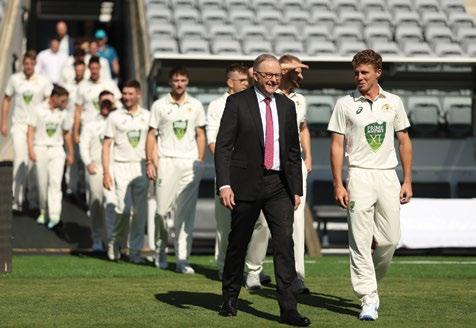
Presented in partnership by


Among the highlights of Premier Allan’s week-long visit were cash incentives for Victorian universities and TAFEs to expand internationally, and a commitment to reserve regional work visas for international graduates. By VIVEK ASRI and LAKSHMI GANAPATHY

IBY LAKSHMI GANAPATHY
n September, on her maiden overseas trip as Premier, Victorian Premier Jacinta Allan was keen to ‘build on our shared success’, leveraging on the status of Victoria as home to the largest Indian-born population in Australia.
As such, her weeklong visit to Delhi brought the announcement of significant measures to strengthen trade and investment ties, and even revealed her penchant for Bollywood.
However, with India as Victoria’s largest source of international students, it was education that took centrestage, with the Premier’s delegation visiting schools like Bharatiya Vidya Bhavan, a prominent Indian educational trust, and Allan addressing the International Education and Skills Summit to invite a deeper exchange of talent and resources.
Inevitably, the visit started off as damage control following the Federal Government’s plans to introduce International Student caps. Victoria accounts for 30% of Australia’s total international student enrolments, and the state government has expressed concern that limiting student numbers could undermine future growth.
Delivering the Australia India Institute’s annual India Oration during her visit to India, Jacinta Allan announced a $5m “Say yes to international students” fund in direct opposition to these proposed caps.
The fund will help expand international education opportunities, encouraging Victorian universities and TAFEs to offer courses to international students through offshore campuses or dual-degree partnerships with education providers abroad.
“We say no to the federal government’s caps. Our new fund is going to help our unis and TAFEs find innovative ways to challenge them, and make our offering to international students even stronger,” she said.
“We say yes to international students because they boost our economy and our global reputation, they support our small businesses, and they keep our multicultural state connected with the world.”
Numerous Victorian universities already have strong ties with India; Deakin University opened a GIFT city campus earlier this year and La Trobe University and Monash University have joint research academies with IIT Kanpur and Bombay respectively.
During her visit, Premier Allan announced an expanded partnership between RMIT University and BITS Pilani and inaugurated the University of Melbourne’s Melbourne Global Centre in Delhi.
Ms Allan also announced that Victoria
would reserve 25% of its Skilled Work Regional Visa (subclass 491) slots for international students who graduate from local universities and TAFEs.
The visa program mandates that successful applicants live and work in regional communities for three years, after which they can apply for permanent residency.
This would provide an estimated 500 graduates with a direct pathway to work in regional Victoria, grappling with skill shortages in industries like advanced manufacturing, hospitality, social services, and tourism.
This visa initiative is part of the state’s broader effort to address workforce shortages in regional areas and divert pressure away from Melbourne’s urban centres. In the last financial year, 365 international students applied for the subclass 491 visa, a number the government hopes to increase.
Ms Allan highlighted that international students are critical to Victoria’s vibrant, multicultural community, adding, “We are ensuring that when students complete their studies, they have every opportunity to live and work in regional Victoria, where their skills are most needed.”
A key moment of the Allan visit was the unveiling of Victoria’s five-year India Strategy, prioritising the expansion of trade and investment tiesin technology and startups, with Allan declaring via her official Instagram she ‘came back home with more
than 500 new jobs for Victoria’.
“With this new Strategy, we chart new horizons, envision new opportunities and strengthen our partnership in an ever-evolving world,” Premier Allan wrote in her Foreword.
Premier Allan met with Indian IT company Firstsource to announce it will establish its new headquarters in Melbourne, and also announced leading AI company Sonata Software will set up a Centre of Excellence in Melbourne.
Victoria is already home to several major Indian tech companies including TCS, Fractal and Infosys who have access to more engineering and IT graduates than anywhere else in Australia.
The new strategy also puts focus on empowering Victoria’s existing Indian diaspora to share culture and language through soft-power and tourism.
Alongside Indian Film Festival of Melbourne’s (IFFM) Festival Director Mitu Bhowmick Lange OAM, a sari-donning Allan attended the Delhi premiere of IFFM’s ‘My Melbourne’ project, hoping to encourage more Bollywood productions to film in Victoria.
Allan also met with organisers of the Pro Kabaddi League to explore bringing a PKL showcase to Melbourne by 2026, reviving the Andrews’ government’s commitment to bringing Kabaddi to the 2026 Commonwealth Games.
“This is our roadmap to shared prosperity. Our partnership spans the distance of more than 9,000 kilometres, but we’ve never been closer,” Premier Allan wrote in her Foreword.

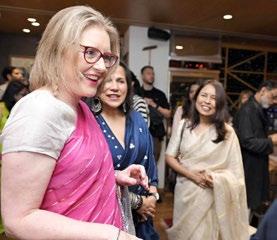

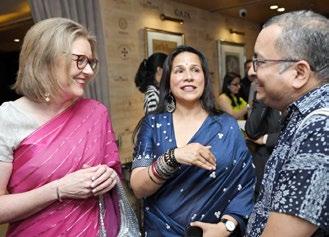
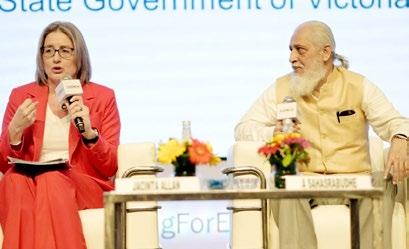
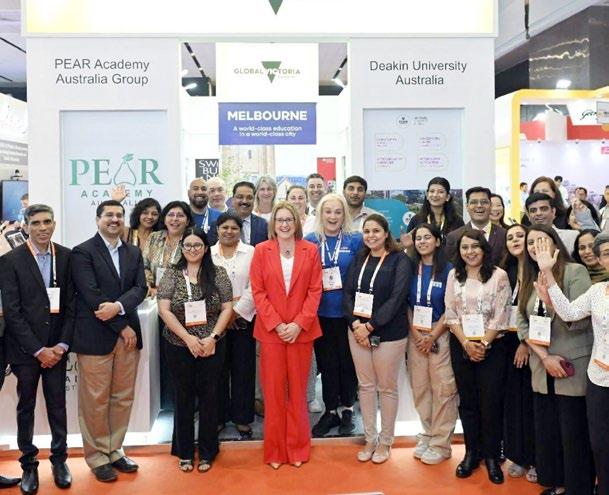





India’s
Minister Piyush Goyal, thank you very much for joining us on Indian Link. You became Minister of Commerce and Industry in June 2019. According to the latest World Bank report, India remains the world's fastest growing major economy, growing at a rapid rate of 8.2% in financial year 2023-2024, while the manufacturing sector grew by 9.9%. (There's a bit of Indian in me coming out here - where did we lose the 0.1%, because 10% would have been wonderful!) Now, is that a good fiveyear report card?
Well, I think India is hungry for more. We are never satisfied with what we achieve. We have a long way to go because there's a lot of catch up to do. There were decades of lost opportunity that we inherited. When in 2014 Narendra Modi became Prime Minister, India was considered a ‘fragile five’ economy, one of the weakest five in the world. Over the last 10 years, we’ve painstakingly strengthened the macroeconomic fundamentals. We have carefully administered reform in the country, focused on transforming the mindset of the
people. Today, we are not only the world's fifth largest GDP, we have low inflation, about 3.5-3.6%. We have the world's fourth largest foreign currency reserves, $689 billion. Very low external debt, so we are not at risk. The currency is stable. And amongst the large economies, we’re the fastest growing economy for many years in a row, expected to continue to be the fastest growing for many more. So we are at a sweet spot, but we are never one to be satisfied.
A recent report from Bloomberg pointed out that Apple manufactured iPhones worth about $14 billion in India during financial year 2023-24, which is 14% of their global exports. They plan to take it up to 25% in the next four years, earning India $25 billion more. That's an enormous faith in the India story, while also a pivot away from China. Your thoughts on the Apple manufacturing story?
First of all, I must compliment Apple for its bold decision.
PM Modi introduced the Production Linked Incentive Scheme, recognising that we have competitive strengths in certain industries. We identified 14 different emerging sectors, and carefully analysed the cost competitiveness and why we were losing out on business opportunity. That was a move that turned out to be very positive for India. We are today the world's second largest mobile phone manufacturer, with over 200 factories producing phones or the ecosystem around phones, whereas we had only two 10 years ago.
The Apple story has truly been a success story. Electronics export today is our third largest export, thanks to large measure to the efforts of companies like Apple. We have now introduced the Semicon mission also, so we'll have a greater domestic value add for all the phones that Apple makes. The big advantage in the India growth story is that we also present a huge domestic demand - 1.4 billion people is a very compelling case - with the rule of law, democracy that we are very proud of. You have a reformist, decisive government;
a leader who can take firm decisions; a very good demographic dividend; young population with skill and talent, and people willing to work hard. In fact, I'm told 70 or 80% of the workers in the Apple factory are women.
So all of these put together with the large demand that India provides in the growing middle class, has encouraged Apple to expand operations in India. Many other countries and companies around the world are seriously looking at the India story. It's not as if it's just a China plus one story for people coming to India.
We are an emerging economy that aspires to be 10x in the next 25 years. We’re about $3.5 trillion (currently), we want to go up to $30-35 trillion by 2047 when we celebrate 100 years of Independence. This growth opportunity has never been witnessed in human history ever before.
But there are issues with youth unemployment, aren't there? It's a matter of how you look at unemployment. Clearly, we would like to see

better quality of employment. We would like to see more people in the formal workspace. But it's not as if everybody is without a job, or there are too many people without a job. Larson and Toubro, one of our largest infra companies, the other day announced that they're looking for 45,000 more people! And in the same company's IT setup, Mindtree, they're looking for 25,000 more people. Just one company in two of their divisions, Infra and IT, is looking for 70,000 people. You'll hear this story across India.
Minister, you're keen to make a strong case for India to become a Taiwan plus one semiconductor country, in which India can be a place for companies to diversify outside of Taiwan for semiconductors. In 2021, India had approved a US $10 billion incentive plan to attract semiconductor chip makers. Three years down, how's that tracking?
I think it's one of the success stories of India. A large part of that money has already been committed. We had the Tatas setting up with the Taiwanese company Fab in Assam. Micron has come to Gujarat. I think Applied Materials has also decided to come in. As one company comes in, the entire ecosystem gets attracted. And the semiconductor industry - I've been engaged with them for some time now - constantly tells me, don't be in a rush.This is a process. First, the design guys come in, then the Amp guys come in, you have the packaging happening. The ecosystem builds up over a period of time. We can clearly see this taking place in different parts of the country. We can
clearly see that India is now recognised as a growing market.
Our estimated semiconductor consumption is about $109 billion by 2030 - it's going to be a big market. We have the talent, we have the skillsets in our workers. (If you look at semiconductor companies across the world, a large part of their talent pool is Indian!)
The World Bank report card I referred to earlier pointed out that lowering trade barriers can help India achieve its ambitious target of $1 trillion for merchandise exports by 2030. Do you feel India is doing enough to achieve these goals, especially in the areas of the retail sector and the dairy industry?
Well, there will be some trade barriers which are necessary to protect sections of Indian industry or farmers. Dairy for one is an area where I have very small farms and the farm owner has two or three livestock, producing a small quantity of milk or dairy. I have to protect them because they really can't compete with the large farms with thousands of animals. Certain sectors deserve and will always require some trade barriers.
On many sectors, we are entering into free trade agreements with different countries. We are working on reducing trade barriers as long as they are reciprocated by the countries on the other side. It can't be a unilateral action. We are working with countries to see what we can do to further strengthen relationships and bilaterally improve the trading conditions. Of course, on a macro level also, there are many major changes being made, for example, to encourage particular sectors, such as leather or apparel industry. So you then keep reducing the trade barriers of those sectors. It's a cat and mouse game. There are some offensive interests, some defensive interests. You have to carefully navigate them.
Minister, now please allow me to use a Facebook analogy. In September 2021, when the Economic Cooperation and Trade Agreement ECTA, was agreed on, both India and Australia changed their Facebook status from ‘friends’ to ‘in a relationship’. Almost three years down the track, this mutual status has yet to be changed to ‘engaged’, by finalising the next step of signing off on the Comprehensive Economic Cooperation Agreement CECA. Can you share with us a timeline on the CECA sign off?
And what is holding it back?
I think there's a great trust and sincerity of purpose in the work that Australia and India are doing to finalise this agreement. India went into election mode this year.
And now I have elections in my home state Maharashtra. And next year you’ll have elections here in Australia.
So I think that's delayed it a little bit. There's no lack of intention. And both my good friend, brother and colleague, Don Farrell and I are
committed to concluding the final stage of the ECTA agreement. At the earliest. We never put deadlines or dates or a gun to the head to negotiate. There are certain issues where both sides have to take a call, you know, MRAs, Mutual Recognition Agreements on the services sector. So we ultimately have to come up with fair and balanced agreements. And both sides have to give some and take some. It's always necessary to give elbow room and try to get the best deal which is in the interest of the people and businesses of both sides.
It is clear that government-to-government engagement is very strong between India and Australia. You've had meetings with Centre for Australia India Relations, Business Council of Australia, Macquarie Bank and others in your visit. Are you heartened by the level of corporate engagement? How has it changed since your last visit to Australia? Well, I've had a wonderful day ever since I flew into Sydney. It's been back-to-back meetings. I haven't had a full meal also, because we were talking over a working lunch… I’ve thoroughly enjoyed meeting friends from the business world, from the investment world, the super funds, tourism related. I just had a meeting with the cruise liners association, and before that with the miners association, to get a macro feel of where we can cooperate and expand relations. The Australian people are very, very easy to work with, very friendly, and I think all these engagements will result in further strengthening our bonds.
The relationship post ECTA has been good. We've been seeing growing trade, increasing participation in the services sector. After that, the double taxation agreement was improvised.
We could do better with tourism numbers. The common refrain in all meetings is more flights, direct flights to Australia from India. But that's an international problem.
We have a shortage of aircraft worldwide.
Yes, I spoke to Campbell Wilson only recently, the CEO and MD of Air India. And though he's getting a delivery of one plane every six days, he's assured me that there's nothing spare to be sent to Australia in the near future. The demand is just crazy. India is going to be the world's largest purchaser of aircraft for the next probably 20 or 30 years. And already this decade, we are the largest buyer.
So I can clearly see tourism becoming one of the mainstays of this relationship. Technology is another very important element of this partnership. ITTT - investment, trade, tourism, technology - is going to be at the frontier of our work with Australia. And I'm hoping very soon to start an office to promote tourism, trade, investments, technology flow through Invest India, the Director General of Foreign Trade, a single stop shop for industrial land or for one stop
“Trade negotiations (between nations) are a cat and mouse game. There are some offensive interests, some defensive interests. You have to carefully navigate them. You give some, you take some.”
approval of all kinds. We're trying to create a setup in one of the cities in Australia.
Sydney, I hope.
I hope it'll be Sydney. The decision will be taken in consultation with industry.
One thing you haven't spoken about, is education. Education is a significant trade between India and Australia. But recently, the government has cut down on numbers. What are your thoughts on that?
Well, I think that's counterproductive from the Australia perspective, because the Indian students who come here bring in a lot of value in terms of education as well as the value proposition to the Australian economy, even in their post-student days. They are also peaceloving, not a community which has ever hurt or harmed the local community in any way. It's a sovereign decision that Australia will have to take. My own sense is the universities will hurt, their revenues will be down. And you may actually have a shortage of manpower in this country.
Tell us a bit about your relationship with Prime Minister Tony Abbott. My friendship with all the senior leaders of Australia have been phenomenal. Tony Abbott was amongst the first big leaders to come to India when we took office in May 2014.
I was his minister-in-waiting so I received him at the New Delhi airport. He's such a pleasing personality, such an easy person to get along with. One of his first comments after I introduced myself and welcomed him to India was, Piyush, can you get me a yoga session with Mr. Modi?
I was flummoxed - just didn't know what to say!
But he's a wonderful leader, a tremendous human being, full of energy, and full of confidence about the AustraliaIndia partnership. He’s somebody whom I've always admired for being the champion of the Australia-India friendship partnership.
After that, I've worked with both Mr. Morrison and with Mr. Albanese, both remarkable leaders of substance. I've had to work with several Australian ministers because I've had portfolios which were very relevant to Australiacoal, mining, renewable energy, powers, all the energy, various portfolios. But I can only tell you, I've enjoyed working with the Australian leadership over the years.
Current Trade Minister Don Farrell is an outstanding human being and a dear friend. I'm looking forward to my visit to Adelaide, when I'll be meeting him and his family. All in all, the friendship between Prime Ministers of Australia and India, ministers at different levels, the people at the frontier of this relationship, we have a great future ahead between Australia.
Minister Farrell has often talked about the lavish feast you laid out for him the last time he was in India. My last question for you - did Mr Abbott get that yoga session with Mr Modi?
(Laughing) Raaz ko raaz he rehne do (Let that remain a secret). PM Modi (keeps) his personal life very private. But the good part is that Mr Abbott's daughter today is a wonderful yoga instructor. So I think there's something which has caught on!
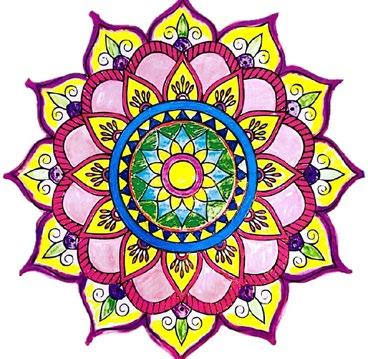

WINNER:











RUNNER-UP:
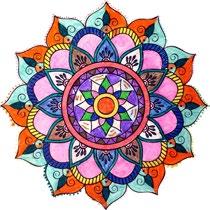






Wiell done to our littlest readers – they’ve wowed us yet again in our annual Diwali Art Contest. Our heartiest congratulations to Sabrina Singh (7 years and under Category) and Rutuja Takle (8-12 years Category) who take home book vouchers valued at $75 each. Congratulations also to Runners-up Keerthana Maroju (7 years and under Category) and Anahita Billimoria (8-12 years Category). They’ve won book vouchers worth $50 each. Look out for our annual Diwali card, which features Sabrina’s and Rutuja’s top-rating designs. Happy Diwali to all the little ones who participated – keep colouring!
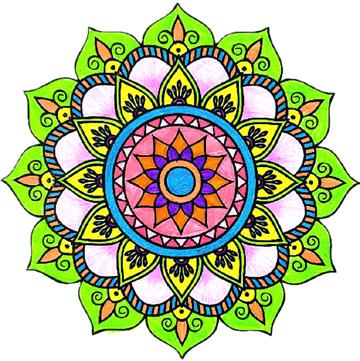





















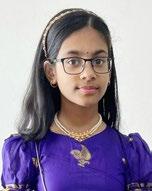


It’s been mandalas galore at the Indian Link office, in the annual kids’ art contest just ahead of Diwali

TBY RAJNI ANAND LUTHRA
welve-year-old Rutuja Takle of Parramatta NSW has won this year’s Indian Link Diwali Art Contest for Kids in the 8-12 Years category.
Seven-year-old Sabrina Singh of Craigieburn Vic took the honours in the younger kids’ cohort, 7 Years & Under. Both take home book vouchers valued at $75 each.
Additionally, their artwork features jointly in Indian Link’s annual Diwali card for 2024.
“I was happy and surprised when Mum told me I had won,” Rutuja told Indian Link.
The mandala-like qualities of her artwork won the judges over. It features a strong central core that draws your attention to inner elements, bounded off by a sturdy and vibrant blue. Lighter layers travel outward, all of them appearing to sit on a final ring of tender paan leaves.
“It took me an hour to make, after I had decided the colours,” Rutuja described. The Year 6 student at Parramatta Public School has been interested in art for as long as she can remember.
“I like drawing mandalas and making rangolis with chalk like Mum taught me,” the budding artist offered. “I work with paints as well as pencils, and I learned a lot

at art classes at the Mahan Art Centre in Parramatta.”
She also learns by watching her architect mum Jyotsna, who herself dabbles in art.
“I’m an architect by profession, but paper quilting is my particular passion,” Jyotsna Takle told Indian Link. “I’ve been teaching the art as well.”
In fact, she revealed, art is a common pastime in her husband’s family, even widespread in the generation above.
“Art runs through my family,” Rutuja laughed.
She is now looking forward to Diwali.
“I love festivals – Ganesh Festival, Navratri, Holi,” she said, but picked for special mention
Gauri Puja, a festival to the goddess observed on one day of the 10-day Ganesh Festival.
“Now it’s going to be Diwali, at which I love the food the most, and then it will be Christmas, at which I love decorating the tree the most.”
It’s a busy festive season for Rutuja, who has a pretty packed life already. Besides art, she is proficient in the piano, and loves her reading – having moved on from The BabySitters Club series to mystery thrillers now.
Seven-year-old Sabrina Singh’s piece is again inadvertently reminiscent of the chakras in spiritual iconography, with its strong central core.
“I picked the colours myself,” she told
Indian Link.
She experimented with gradient, and exaggerated the borders, showing she has been dedicating serious hours to art – or at least, colouring in.
“I love to make art,” the Willmott Park Public School student declared. “I am now learning to do anime art at school.”
Is she looking forward to Diwali?
“Yes, I will make rangoli with Mum – if there is time.”
We are sure she will find time – after she’s done with her writing, karate, dancing and singing.
The runners up positions went to Anahita Billimoria and Keerthana Maroju in the 8-12 Years and 7 Years & Under categories.
They win book vouchers worth $50 each.
The annual Indian Link Diwali Kids Art Contest is here to stay. Many kids like Rutuja submit every year, and inspire younger siblings to participate as well. (The Takle family were pleased to see four-year-old Ritika shortlisted as well). Finalists revealed they were spurred on by parents who saw the mentions across social media, print and enewsletter.
The contest began as a modest school holiday activity to get the kids into a Diwali frame of mind, and teach them the simple moral lessons behind the grandest Hindu festival. Today, it is aimed at including the youngest members of our community in the spirit of Diwali in a manner that resonates with them.










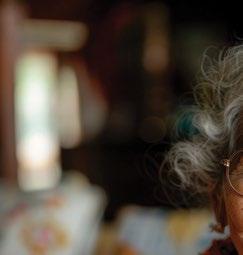





India’s national carrier is going through massive change after moving from government to private ownership. Overseeing this transformation is CAMPBELL WILSON, CEO and MD of Air India. He shares his vision for the world’s fastest growing airline, with PAWAN LUTHRA.
You’ve been in the pilot seat at Air India for just over two years. What’s the flight been like so far?
Certainly exciting and interesting. There’s been a lot of activity, a lot of interest from people both within the airline as well as people in the broader community and internationally.
I think we’ve made some good progress in fixing some of the burdens that have come with the airline upon privatisation. We’ve set some good foundations to support the ambitions, and we’re now in a good place to start realising there’s ambitions with growth, with product upgradation, with network expansion that will come over the coming few months and years.
Though Air India is a national brand and pride of the nation, it has suffered from decades of underinvestment. Average age of the staff was 54, with a retirement age of 58. Emails were being sent from Gmail accounts. You had come from one of the leading airlines in the world, Singapore
Airlines, where you had worked for 26 years. Was it a baptism of fire?
Well, it wasn’t a surprise. It was quite well known in the industry that Air India, which had been amongst the best airlines in the world in decades past, had suffered this underinvestment and was in pretty bad shape. In fact, it was well known that it was probably in terminal decline. So going in, it wasn’t a total surprise, but certainly some of the things were a little bit shocking.
Why take this job?
A fantastic brand. A 92-year legacy. A country that is rising onto the world stage. So much passion and pride in what Air India could be. I don’t think there’s a more exciting job on the planet, certainly not in aviation. I knew it wouldn’t be easy, and it certainly wouldn’t be something that we could turn around overnight.
But it’s an opportunity to make a difference and do something significant, unmatched anywhere.
So, two years, two months down the track – I believe you joined in June 2022 – what’s been the most exciting thing for you? Was it the $70 billion order you signed off on for the 470 aeroplanes?
Well, certainly being on a video call with President Macron and Prime Minister Modi was probably one of those career milestones! No, there’s been lots of highs, obviously that being a significant one. (Among these are:)
• The receipt and deployment of our A350, which is a fantastic interior product, wonderful customer reviews, now operating Delhi-London, and soon DelhiNY.
• The upcoming merger with Vistara and all the work that’s going on behind the scenes to lead into that.
• The opening of our new training academy, which is seeing 2,000-odd people go through a day for initiation or upgradation training.
• And just seeing the 5,000 new, young, enthusiastic cabin crew coming into that facility and being impressed and
ultimately coming out the other end as representatives of the nation.
There are many, many highs. Every week has a high. Most weeks have a surprise too.
Can you share some of the surprises? Probably best I don’t. I can leave them for another time.
Will you be surprised if the New Zealand cricket team beats India at any stage? I’ll be extremely surprised, especially in India (laughs). Outside India, maybe a fighting chance. Inside India, not so much.
The average age of an Air India employee has gone from 54 to 35. How did this eventuate, in terms of the people who were on the older end of scale?
Because Air India hadn’t recruited since 1999, the average age of employees was 54, with many people quite close to retirement. And those people had spent almost their entire career in a public sector environment. The transition to a private sector
environment with different performance management criteria, different demands and expectations was a little bit, I guess, concerning or traumatising for people. And we made available a voluntary retirement scheme. In fact, we’ve done three tranches of voluntary retirement scheme so that people who didn’t feel confident in making the transition or people that didn’t receive the position that they would like to receive or had other opportunities, could exit the business in a comfortable, respectful and ultimately voluntary way. About 3,000 people have taken the opportunity to leave the business through that voluntary scheme.
Of course, many people reached retirement age during the last two years and so left as a normal process of superannuation. For the first time, Air India has applied a performance management scheme whereby people had a job description, they had performance expectations. If you didn’t achieve the performance expectation, there’s coaching, counselling and ultimately there’s an indication should you stay or move to another position or another organisation.
It’s been a gradual, respectful process of transitioning from a public sector business to a private sector one. The average age coming down is largely a consequence of bringing in new people. 9,000 new people have been recruited into the business and so that obviously has brought the average age down considerably. For cabin crew, 28 is now the average age.
Going back to the hardware, you ordered 470 planes, leased another 36, and repurposed a further 30 grounded planes. That was an addition of some 550 planes to the Air India fleet, at a cost of about $70 billion. You’re getting a new plane every six days. With growth in the Indian aviation sector both domestically and internationally, would you say you’ve under ordered?
Well, there’s a lot to digest within the numbers you’ve just described. But India’s growth gives us confidence that certainly the number that we’ve ordered is not unreasonable, and in years to come it will be clear that Air India will have to order more aircraft. But we’ve got to digest these ones first, obviously.
India is already the world’s third largest domestic air travel market. It’s the fifth largest international air travel market. It’s growing at a compound annual growth rate of 8-10%. It’s a huge international diaspora. India’s becoming a stronger part of the global supply chain. It has the same geography to accommodate international to international hub flows as the Gulf.
There are many reasons why India can
become an exponentially larger air travel market. I think in that context, the number of aircraft we’ve ordered is modest. But when we will take further orders, that’s a matter for time to tell.
Now, while we’re talking about the planes, you would have heard about customer dissatisfaction with entertainment systems and seats. Yet, inspite of all this, Indians still want to travel Air India. Why do you think that’s the case?
I talk to people in India all the time and they say almost without exception, my first flight was on Air India, I love Air India, I fly Air India because it’s my national airline, I love the Tatas, I want the Tatas to succeed, I want Air India to succeed. There’s huge national pride and support of Air India.
At the same time, it comes with the expectation that Air India gets better and represents India in the way that people want it to be represented. We do face the criticism – deservedly so in some cases – that we’re not meeting quite that quality. We’re doing our best to fix it as fast as we can.
A third of the wide-body fleet, for example, is up to international standard with seats and entertainment systems. Very high net promoter scores – up to 70 in the case of the A350s that are now flying to London. But the legacy wide-body aircraft still have the same seats and entertainment systems that was delivered with the aircraft a little bit more than a decade ago.
We’re going to be refitting all of those aircraft with new seats, entertainment systems, connectivity. We were going to be starting 2024 in fact, but the seat suppliers have had production and certification constraints which has delayed the start of that until 2025. In 2025, we’ll put all of the legacy 777s and 787s into a refit program, so that by the end of 2026 or thereabouts, all of the Air India widebody fleet and narrow-body fleet will have been upgraded to world-class standards.
We have an IT professional like Elon Musk running a car company, Tesla. What’s it like for an airline to be owned by Tata Sons, which has arguably some of the best IT engineers in the world?
We draw a lot of benefit from different parts of Tata Group. IHCL Hotels, Taj Sats Catering, Tata Technologies (doing a lot of the design work and helping us rehabilitate the interior product), TCS clearly contributing a lot to IT.
I could name a dozen other Tata companies that are contributing to the cause. But if you look at the transformation we’ve made on the IT side, to directly answer your question, 85 systems in the airline have been replaced. We now have, I would say, probably the most modern IT platform of any
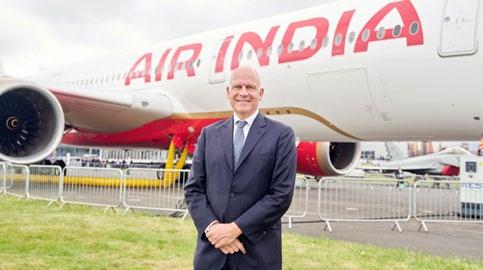
airline in the world.
We’re not yet fully utilising it because we’re still building our own capabilities and business knowledge. But the technical infrastructure is now second to none. Our app has gone from terrible to 4.7 on Apple Store.
BitSight rating in terms of IT cybersecurity is now equal with the best in the industry. The website is number one ranked in Google Lighthouse rankings. So, it’s literally transformed in less than two years from absolute laggard to one of the absolute leaders.
That couldn’t have been done without the contribution of people from Tata. Both people from TCS, Tata Communications, but also people that have joined Air India, some of who came from parts of Tata.
You seem to have many balls juggling in the air. What keeps you awake at night?
As an airline CEO, you don’t sleep very much anyway. For me, it’s always about safety and about the robustness of operations. And that’s not to say that there’s any cause for concern. It comes with the job itself.
Singapore Airlines may soon have a 25 per cent stake in Air India, subject to government approvals. What benefits do you see for Air India in this alliance and for Singapore Airlines?
Well, speaking for Singapore Airlines is probably not appropriate, but I’m sure their investment is predicated on the huge growth opportunity of the Indian market.
And they also want to see the work they’ve put into Vistara go to support Air India, because back in the day, early 1970s, it was Air India that actually sent people to help do service training for Singapore Airlines when it started.
So maybe it’s karma.
From an Air India side, Singapore Airlines will be an equity investor. It won’t have any management roles. But because of that financial investment, they contributed a lot of assistance in terms of hosting our people to see how they do certain things, so our people can learn faster, sharing knowledge, assisting us in establishing a base maintenance organisation, for example.
So it’s about knowledge exchange and transfer. Obviously, they help a lot, and we’re very grateful for it.
Coming to Australia, we have 17 flights currently from Sydney and Melbourne to Delhi and Mumbai. Can we see a few more soon? Can you spare us one plane, from those that come to you every six days?
All the aircraft that are coming at the moment until the end of next year, are narrow-body aircraft that simply don’t have the range to get to Australia from India. They’re either
domestic or short-haul internationals – to the Gulf, to Southeast Asia. So sadly, I can’t commit any more aircraft to Australia just yet. But clearly, the plan is to expand – both the number of cities that we cover, as well as the frequency. It is an important part of our network. It’s just dependent on how quickly we can receive these wide-body aircraft.
India prides itself in exporting CEOs. Yet it had only 28 non-Indian expat CEOs among the 2,521 CEOs at the end of financial year 2023-24. India is a diverse country with expats challenged on culture fit, understanding of the market complexities, and regulatory systems. What would your advice be to the 29th non-Indian CEO considering a transition to India?
I don’t know that it’s my place to give anyone advice. I would say, come with an open mind. Because when you have a mental picture of doing business in India, whether it’s business to business, whether it is business with regulator, it’s probably outdated.
The new India is much faster-moving, much more open to change, much more professional than the dated perception might have been. Certainly, I’ve found it incredibly easier to do business, to effect change, to get progress than I had perhaps anticipated. So come with an open mind.
Any other advice over that single malt scotch?
(Laughing): Develop a taste for single malt scotch.
Finally, a question about the beloved Maharaja. He’s way past your retirement age – 78, I believe, having been created in 1946. Does he get a performance review too?
You’ve already seen some changes, but we have to be respectful of the past at the same time as we need to evolve the airline to meet the current and indeed future expectations. The role of the Maharaja has changed a little bit. As opposed to being a cartoon cardboard cut-out, we’ve elevated and refined it. It’s now a signifier of quality class and service that you’ll find on the glassware in our first class, for example, or the chinaware in first and business class. But the ethos of the Maharaja, the warmth, the service, the Indian hospitality, is really now part of the DNA of the airline, the training regime, the service philosophy. So whilst it might not be there as a physical image in the way it was, certainly it’s still very much with the airline.
So you’ve cloned the Maharaja into the new staff that come through - all 7,000 of them?
(Laughing) Absolutely.

Iam no stranger to living alone. So, cooking for one should be an exercise I should have mastered by now. Not really, because several variables come into play. From what I am in the mood to eat, to what’s in the fridge that is wilting, to my energy levels.
I also have to factor in the weather. Sambar can never be made in small quantities – and in summer, the dish can be hard to finish as it lasts for at least two days – if I eat it for lunch and dinner, which I don’t. The effort in making the dish itself puts me off from cooking it often, healthy though it is. The same applies to my Sindhi curry – the dal and tomato versions.
I work from home, so there are days when I have absolutely nothing to do and others, when a deadline is to be met, so no time for an elaborate meal. I go with the basics on those days – a one-pot dish like a pulao – which can be had for lunch and dinner. Fried rice, if there is leftover rice, makes for a fine alternative too. I find making juliennes of a carrot or chopping French beans quite therapeutic.
Then there is the health factor. Recently, some tests showed an excess of uric acid, so the doctor advised me to reduce my protein intake. Happy to, I started including salads in my meals. This change has led to the discovery of salad dressings with different ingredients and flavours. Besides, a bland Mediterranean dish like pasta and a salad is
easier on my chronic IBS.
When it comes to Indian food, I find it an absolute bore to make rotis – from kneading the dough to rolling them out. And much as I love pooris, I desist from making them for the very same reason. Luckily, I found an innovative solution. I buy the ready-to-cook roti variety, cut pooris out of them, and I have my pooris without the effort. The leftover dough I feed the pigeons.
Having said that, the health of my rottweiler Tutu has bearings on what I consume. Her health is directly proportional to the amount of junk food I eat. If she is unwell, I often tend to skip meals too… or if her reports are anxiously awaited, I will eat samosas, cakes and chips, till she gets better or her reports show an improvement. I don’t know what the connection is, and I haven’t analysed why I do that either.

I have discovered my love for sourdough bread too. In summer, I have it with a chilled beer and in winter, a cup of garam chai.
On the whole, I find cooking a meditative exercise. From chopping the vegetables to making the salads and eating only what I truly enjoy, I can space out while cooking and be completely in the moment. Isn’t that what meditation is all about? Besides, cooking for myself has brought home the importance of healthy eating. The discipline to not eat out by ordering on the food delivery apps, more than once a week too has been a hard-to-form habit.
Most important has been the vital role comfort food plays in uplifting my mood. Due to upheavals in my personal life, which inevitably reflect on my food choices, I have some favourites which always make me feel better. If my acidity isn’t playing up, then Paani Puri is an all-time favourite. And, a weekly staple, usually on the weekend, an absolute must-have for me has to be the grilled chilli cheese toast – with a slice of cheese and some green chillies in between slices of white bread. I am not a fan of the brown and healthy bread varieties – they taste like cardboard. This ritual, carried on for years, where no matter how good or bad the week has been, makes me feel good about myself. In the process,
But my forever go-to during any kind of emotional crisis has to be a chocolate pastry. Not just the plain loaf cake variety, but the pastry, complete with gooey chocolate ganache or cream on top. My heart could be breaking, I could be in the midst of a panic attack or worried out of my mind about my dog’s health. Eating it straight out of the carton, even if it is a spoonful at regular intervals, a chocolate pastry is my calm-me-down piece of magic. It has also been a gentle roadmap to loving myself. A reward for every milestone, and a support system during every setback. If I have a chocolate pastry to reach out for, I will be okay and my world is not coming to an end.
If you are single, recently separated or widowed, or a young person in a new city, still making your way through life but living on your own, let food be your guide to selfdiscovery. From failed cooking experiments to finding what dish touches your very soul, or your favourite comfort foods, cooking for one can and should be your gateway to self-love.
Minal Khona





















































































































































































































































































































































Celebrating three decades of connection and empowerment
Three decades of all things Indian. In Australia.
Melbourne-based TARA RAJKUMAR OAM, acclaimed Kathakali and Mohiniattam dancer, performer par excellence, revered guru and mentor, researcher and developer, talks to SUMATHI KRISHNAN about her 50-year career

How would you describe the significance of dance to you and to society?
Dance means everything to me. Within the intrinsic technique and aesthetics of my life-long dance practice, the goal is to create Rasanubhuthi, an emotional essence that transports the audience to a different realm.
Dance reflects society, and as an early post-colonial artist, I found a connection between my cultural roots, sculpture, religion, music and dance. When I perform, I embody the dance and take the audience on a journey through expression (Abhinaya). That is why my dance practice is significant to society - it carries the essence of my culture and creates an emotional connection.

What challenges have you faced, if any, in your dance practice?
One of the earliest challenges as an emerging dancer was developing the confidence to perform solo, mastering technique and aesthetics, and commanding an audience’s attention for a full evening performance.
Later, working in the UK and in Australia, I realised the importance of building cultural bridges. This led me to create contemporary works like ‘Mary Magdalene’ and ‘Temple Dreaming’, to show that my dance idiom can connect with wide and varied audiences through my repertoire.

A performance from your career that stands out in memory?
Two experiences come to mind. The first was in Britain, when I demonstrated the "Ekalochan" technique, where one eye expresses grief and the other anger. It really created a buzz. An ophthalmologist in the audience stood up and expressed his amazement watching this ability to express

two emotions simultaneously.
The second was when Prince Charles saw me perform in the early 1970s and expressed his interest in and intrigue about my particular danceform. Both experiences left a significant impact on me.

A starry night or a rising sun - when are you most creative?
I often get creative when I am in solitude, looking out into my garden. It is during these quiet moments that my mind wanders, and ideas flow. Solitary moments bring out my creativity the most.
But it is also when I am doing the most mundane of tasks, like washing up, and I let my mind wander!

Finish the sentence: Art is … Art is a big word — it is in everything that brings joy. When one immerses oneself in one’s art, embodies it, and projects that love and joy to others, there is art in that connection. For me, art is a culmination of different influences—dance, religion, and culture—that come together in my performance. As an early post-colonial artist, my practice ties together these diverse elements into one installation of being and expression. As a migrant in a multicultural society, contemporary expression of one’s artform is critical and necessary to become and stay relevant.

Physical exercises must be an essential part of your daily routine. Which exercises would you recommend for budding dancers?
Ideally Suryanamaskaram and yoga breath control. For Kathakali and Mohiniattam dancers, there are specific exercises. The dances often involve heavy costumes, so we practice circular patterns, body movements, eye exercises, breath control, and balance


In Kathakali, dancers wear heavy headgear, so we train to hold our heads steady. Each dance style, like Odissi, has its own unique requirements, so stamina must be built gradually.

Art for yourself, or for others?
Primarily, art is for myself. If I do not create art for myself, I cannot share it with others. I must first feel and create it, and only then can I communicate and connect with an audience. At the
same time, I believe in the ‘Three C’s’, ie, Communicate, Collaborate, Create. I constantly look for ways to collaborate and research how we can practice this artform in Australia. However, confidence and ability in one’s classical roots are essential before we can successfully collaborate with others.
I pay homage to my gurus, collaborators, students, parents and you the Rasikas. I humbly bow to this art form, my dance, which has given me the privilege and honour to take my India with me wherever I go!
Tara received an OAM in 2009 for her service to the performing arts, and was included in the Australian Government’s Inaugural Honour Roll of Women Shaping the Nation during the Centenary of Federation in 2001. A documentary of her work, Tara the Singing Anklet by the acclaimed M4TV Productions premiered at the Indian Film Festival of Melbourne 2023 and was screened recently at the NSW Parliament at the South Asian Film and Art Festival 2024 (supported by ICCR and Swami Vivekananda Education Centre).
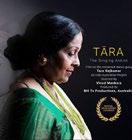


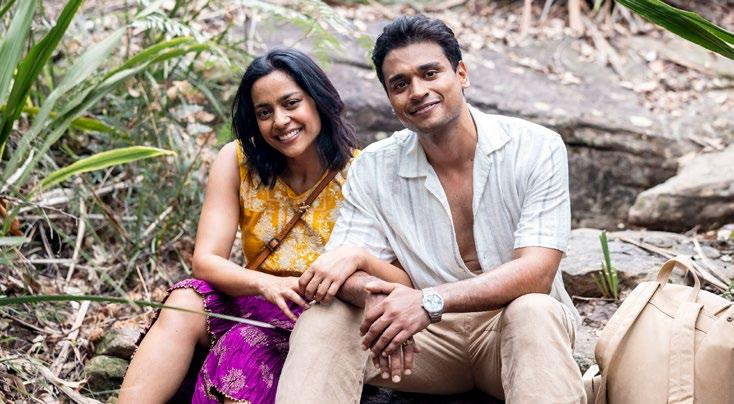
The stinging agony and the giddy passion of a long-distance relationship

IBY LAKSHMI GANAPATHY
s it any surprise Mithila Gupta, creator of SBS’s latest romance drama Four Years Later loves Shah Rukh Khan?
An eight-episode series following Jaipur newlyweds Sri and Yash who must reconnect in Sydney after four years apart, it’s easy to see the imprint of blockbusters like Kuch Kuch Hota Hai in how expansive the series feels, and the way it coalesces past and present.
“I feel nostalgia sometimes when there’s no nostalgia there; there’s something about how we look back at our past, depending on how we’re feeling in that moment, that I’m really fascinated by,” Gupta says.
But Four Years Later is a tenderly rendered saga far from the grand gestures of Bollywood, or even the broad strokes with which migration stories have been painted previously.
Moving to Sydney with her family when she was four, Gupta’s early education on love and relationships came from Hindi cinema and watching her parents build a new life. In lockdown, after limited dating success, she entered her own movielike longdistance relationship.
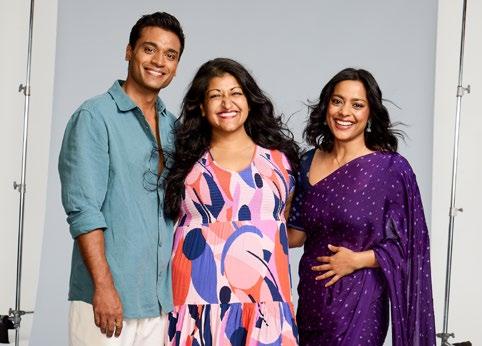
‘I was like, I give up. I’m not doing this anymore,” she remembers. “My dad took my Hinge profile and started swiping; when he landed on my husband he said, ‘you should go for this one, he has a very honest face’…so I went on a date with him. We were separated over lockdown for five months… now we’re married. In many ways, that was a modern arranged marriage.”
The highs and lows of maintaining a relationship over Zoom inspired her to write this authentic romance series which

keenly observes the stinging agony of love just as much as it does the giddy passion.
A celebration of South Asian success, the series features compelling performances from Shahana Goswami (Bombay Begums, A Suitable Boy) and Akshay Ajit Singh (24: India), writing from Nicole Reddy and S. Shakthidharan, and original music from Isha Ram Das, featuring L Fresh the Lion.
The series also breaks new ground in its depictions of intimacy, refreshingly upfront in showing South Asian desire.

“I have never really seen anything that inspired me to feel sexy, or emotionally open or like I could be a leader,” Gupta says. “When it comes to sexuality, I feel like we’ve got a glossy version, but not the real version, and if we have had the real version, it surely hasn’t been starring South Asians.” It's earnest, detailed storytelling that rivals that of streaming hits Normal People and One Day – both of which have tonally influenced the series and demonstrate the appetite for honest romance dramas.
“My tongue-in-cheek pitch for Four Years Later was that this is Normal People, but with brown people,” Gupta laughs. “It was really great to have that as a reference so people could get a grasp of intimacy and love and the pace of storytelling.”
But Four Years Later doesn’t simply ride on coattails; it blends romance genre sensibilities with Indian culture in a way never seen before on our screens. It ascribes the modern romance’s hallmark tenderness to an arranged marriage, challenging even the hardest MAFS-watching cynics to see the joy and affection possible through our cultural matchmaking.
“The kind of philosophy I’ve always been told is that love grows,” reflects Gupta. “I think sometimes outside of the arranged marriage culture, we expect love to slap us across the face and everything to fall into place. I’m guilty of that also. But I just think there’s something beautiful about arranged marriage.”
Equally, it pushes the envelope for migrant storytelling, jettisoning the doeeyed foreigner trope with tequila drinking, freewheeling Sri, and moving beyond simplistic representations of racism and homesickness through nuances in characterisations and language.
“I didn’t want to tell a story about race politics, but I couldn’t tell a story without race politics,” says Gupta. “What we went for is ‘what are the more unexpected, more nuanced moments?’ We found [the character of] Arun, an Indian bloke who’s been born and brought up here and spent a lifetime trying to fit in and who doesn’t want to lose that a far more exciting antagonist than a bully white guy.”
Gupta feels dizzy with excitement at the prospect of audiences connecting with the multi-layered storytelling.
“I want specifically people of a similar culture to mine to feel seen because we haven’t really had a chance on Aussie screens. But I want anyone who watches this to find an element that they can relate to,” she says.
“As the series goes on, you’ll find that even the Australian locals and even the people of diaspora, everyone’s an outsider in one way or another in this story. And I think that’s probably true to a lot of the isolation we all feel as humans.”
Watch Four Years Later on SBS Demand.

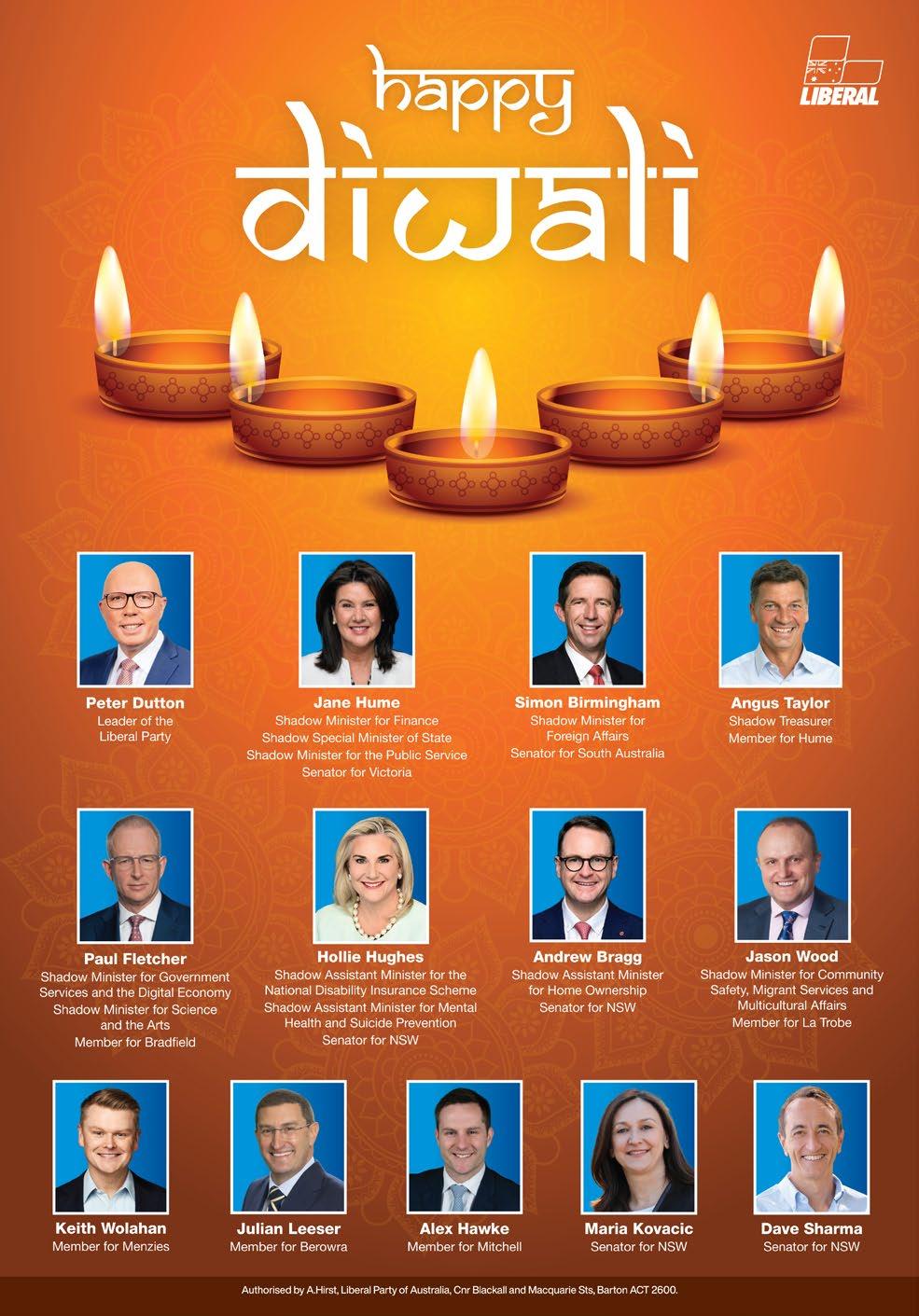
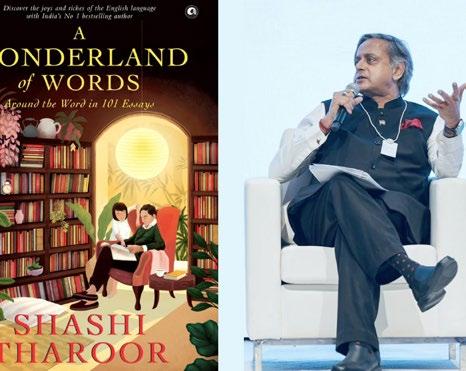
Clearly, in Shashi Tharoor’s mind, writing a weekly column on words for three years was not sufficient to reveal the beauty of the English language. In his new book A Wonderland of Words: Around the Word in 101 Essays, Tharoor is no longer constrained by the 800-word limit and fully embraces his public identity as a vocabulary fanatic. From exploring the origins of words, to the confounding rules of grammar to the masterful use of language by writers, Tharoor’s book is a dream for any wordsmith whizz or grammar geek (or an alliterative author, like me).
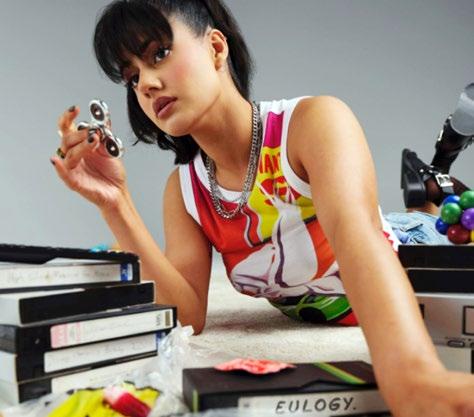
Turns out that actress Ayesha Madon has a musical alter ego. Her style of music fits comfortably within the genre of Gen-Z alternative pop, which is characterised by melancholic lyrics, backed by an upbeat track. In her song Eulogy, Madon expresses her desire to achieve self-acceptance, singing lyrics that are all too relatable for anyone in their twenties. Blame Me, however, is for all those in their unhinged era, who are experiencing unrequited love or feel a perpetual sense of yearning. If Conan Gray is on your playlist, then Madon’s music will also be your cup of chai.

Imagine a show that does all the following: presents an arranged marriage as romantic, insightfully explores the desires of brown people and tackles topical issues of migration and racial politics. Mithila Gupta’s Four Years Later does all the above. But beyond all this, the show is just a good romance as the first few episodes guide you through the thrills experienced by the show’s central characters. So, if you’re feeling sorry for yourself for being single, Four Years Later is a great show to put on to vicariously experience a romance in all its messiness.
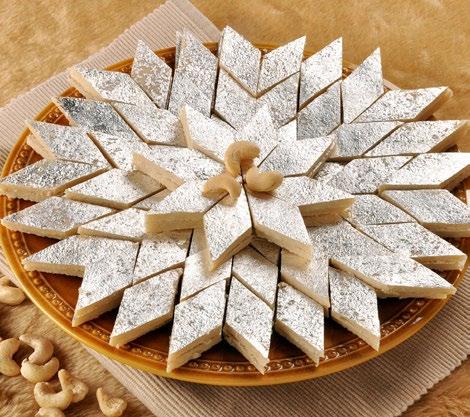
‘Tis the season for Kaju Katli, as Diwali is just around the corner (although arguably every occasion calls for Kaju Katli). While it’s a delicious sweet, it’s guaranteed that for most kids, the attraction to it had less to do with its taste and more to do with its shape and the fancy edible foil on top! Turns out that it’s super easy to make too. All you need are the staples of a typical Indian pantry including, cardamom, rosewater, cashews and ghee; no need to go on a wild goose chase in your local store! (See recipe on Pg 44) COMPILED BY SRUTHI SAJEEV


ANUSHKA PHAL is an educational developmental psychologist and founder of Umeed Psychology, a private practice and social enterprise providing accessible, culturally informed mental health support. She is also a founding member of Guardians of The Pacific, Co-Host of the ‘Girls That ADHD’ podcast, and a 2023

What’s your current ‘umeed’ for Australia’s mental healthcare system?
Start making mental healthcare accessible for everyone. It's great that we have 10 Medicare rebated [sessions], but there’s a disparity in how much you receive…everyone should be getting the same rebate. Finances are a big barrier for a lot of people seeking mental health service.
People say therapists should just reduce their fees. Trust me, we’re trying…we're people too and we have to pay for things like admin in the background. We don't get to keep that whole amount for that one hour. I think that’s important [to balance], that the therapist is getting paid but everybody else is also getting access to mental healthcare.
I think my [other] hope is we stop measuring the effectiveness of mental health outcomes on productivity. I am tired of hearing ‘mental health costs Australia $10 million plus every year’…if we provide the appropriate services for everybody, their outcomes will naturally be good and that will eventually affect the economy.

If you had to counsel yourself, what would you say?

Lots of multicultural mental health practitioners talk about ‘breaking intergenerational patterns’ - what does this actually look like?

intergenerational conflict.

‘Just because you can, doesn’t mean you should’…in the past I’ve fallen into the habit of trying to do all the things because my empathy gets really big. A balanced life doesn't have to be ‘5:00 AM doing your gratitude journal drinking your herbal tea going for a run and then doing your productive day.’ It can be you get up, you ate breakfast and you watched TV, and then you had a good day because you did enough work and not too much work. That's probably a big one. Balance is something that I struggle with a lot.
Something that might have happened to your great grandparents is still affecting you right now because that has trickled down. A classic example of this is Partition… A family that otherwise would have been thriving suddenly went into survival mode and all that mattered was keeping a roof over your head, educating your kids, and having food on the table. What I'm finding with people between the ages of about 20 to 35 is they really struggle to break the trauma of survival and actually enjoy thriving. Those
At the end of the day, the key is trying to understand your own intergenerational patterns and history. Knowing what your traumas are and being able to break through them - that happens through discussion, which is a big barrier in South Asian families. We don't talk about things…I think that's where emotional literacy is important, like, it's okay to have feelings.

What's something that you're currently listening to/reading/ playing/watching?
I’ve been going through my Percy Jackson phase this year - been obsessed with Greek mythology because I needed something that was in touch with my childhood.
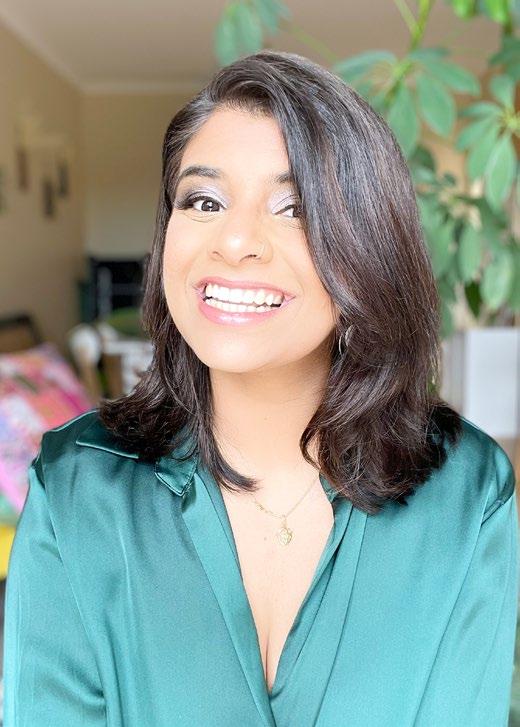
If you’re South Asian or even from a multicultural background, read ‘Chai Time in Cinnamon Gardens’ by Shankari Chandran, and I just finished reading ‘All That’s Left Unsaid’ by Tracey Lien.
What’s a word that you like in a South Asian language, and what does it mean?
I’m going to be really biased and say ‘umeed’ [which means hope in Urdu]. I started my business on a whim; somebody called me, and they were sad, and then I was like, ‘give me a day’ and I registered an ABN. Since then, I've had a lot of time to reflect and it’s a beautiful word because hope can mean so many things for so many different people. A little bit of hope goes such a long way; if you have just a little bit of ‘umeed’ in yourself or the world or whatever it is, you can make it, you know.

And finally: Soan Papdi or Papdi Chaat?
Papdi Chaat. My neuro-spicy brain has [strong] feelings about the texture of Soan Papdi.

Ancient forest worlds and underwater experiences. Port Douglas is home to two of Australia’s most stunning natural wonders.

LBY SANDIP HOR
ike me, many others from the large Indian diaspora in Australia love Barramundi. Perhaps the fondness comes from its resemblance to a popular saltwater fish in India called Bhetki in West Bengal and Chonak in Goa. So it was a thrilling experience for me to hook a Barra at a local farm in Port Douglas, a gem of a seaside nest tucked at the northern top of tropical Queensland, where the climate has synergies with tropical India.
Sometimes referred to as the Asian Sea Bass or the Giant Sea Perch, the fish naturally grows in the region’s saltwater waterways but is also farmed by many local entrepreneurs in ponds. At the Hook A Barra Fishing Farm, for example, besides the cultivation of the fish, tours are available to learn more about the species, and the opportunity is there for you to angle one –only to be returned to the water after the selfies for bragging rights.
As fresh barramundi is abundantly available, most Port Douglas eateries have at least one dish on their menu dedicated to this fish. I tried a few: a whole fish deepfried, sauced, and served with rice at the famous Siam by the Sea Thai restaurant,

and fish cakes at the Seabean Tapas Bar Restaurant. While browsing for a suitable dining venue, I found the little township thriving with multi-cuisine eateries, all of which are overcrowded with customers on a weeknight. This showed me how popular the destination is for holidaymakers.
However, the scenario was entirely different forty years ago, when Port Douglas was a sleepy fishing village with a mere population of around 300. Transformation began around the mid-eighties, when business tycoon Christopher Skase spotted the location as a sophisticated tropical playground for the rich and famous.
Soon he built the Sheraton Grand Mirage Resort, which since opening in 1987 has hosted several celebrities, from former US president Bill Clinton and wife Hillary to Hollywood superstars like Kate Hudson, Matthew McConaughey, Leonardo DiCaprio, Tom Hanks, John Travolta, and others.
Over the years, many more dreamy resorts mushroomed, making Port Douglas a resort destination. However, the laidback atmosphere still exists. The town doesn’t have any traffic lights, no fast food joints like KFC or McDonald's, or even high-rise buildings.
While Bill Clinton loves playing golf here and perhaps other celebrities fancy its isolated seafront location as an ideal escape
Getting There Qantas, Jetstar and Virgin Australia fly from key Australian cities to Cairns, from where Port Douglas is only 66 km by road.
Stay The most popular resorts are dotted near the famous Four Miles Beach. Peninsula Boutique Hotel (www. peninsulahotel.com.au) and Oaks Port Douglas Resort (www. oakshotels.com) are two of the






from the rest of the world, the key attraction of most of the other visitors is exploration of the two World Heritage-listed natural wonders - Daintree Rainforest and the Great Barrier Reef. Port Douglas is the gateway to both.
A day-long guided tour introduced me to the beauty of the Daintree Rainforest, said to be over 180 million years old. Spanning some 1200 square kilometres, it’s the nation’s largest rainforest and is home to living examples of unique ancient plants as well as thousands of species of birds, animals, and reptiles not found anywhere else in the world. Like the very rare and endangered Cassowary flightless bird - which can be spotted here in the wild if luck permits. The national park starts at Mossman Gorge and continues up north to Cape Tribulation, where the rainforest shakes hands with the ocean and the reef.
The Daintree River goes through forestry, and a popular excursion is a boat ride along the river to see saltwater crocodiles amongst the riverbanks or mangroves.
To me, the rainforest excursion was a complete immersion in nature and a total disconnect from the modern world. It was like being transported to a raw, wild, ancient environment resembling Jurassic Park, where at times it appeared entirely possible that dinosaurs might emerge from the lush undergrowth.
The Great Barrier Reef, alongside Kakadu and Uluru, is one of Australia’s most amazing natural wonders. This iconic natural world is home to some 2,700 individual reefs, brimming with countless fish, sea, and coral species, providing some of the planet’s most spectacular underwater experiences. Most explore the reef from Cairns, which is a modern and high-energy seafront city, but many say venturing out from Port Douglas, which is an hour’s drive north from Cairns, is a different experience, though the outer reef is a bit further away. However, there are various tours available from the Port Douglas Marina to take aqua aficionados to the inner or outer reef region for snorkelling and scuba diving.




We’re hoping to make a lasting impression on our guests with the classy Sandwich Kaju Katli. It’s got a delicious filling that combines different flavours and textures for a festive treat they won’t forget!
Ingredients
For the kaju (cashew) base:
n 2 cups cashews
n 3/4 cup sugar
n 1 tbsp ghee
n 1/3 cup milk
For the stuffing:
n ½ cup mixed nuts (almonds, pistachios, walnuts)
n 1/4 tbsp gulkand (rose petal preserve)
n 1/4 cup dates, pitted
Instructions
To make the kaju base
n Coarsely grind the cashews in a food processor until they reach a fine, powder-like texture. Be careful not to over-grind, or it may release oil and become pasty.
n Add the sugar to the ground cashew powder and pulse together in the food processor until well combined.
n In a pan, heat the ghee over medium heat. Add the cashewsugar mixture and pour in the milk. Stir continuously, ensuring the mixture doesn’t stick to the pan.
n Keep stirring until the mixture comes to a thick, homogenous dough-like consistency. It should come together and pull away from the sides of the pan.
n Transfer the mixture onto a tray lined with parchment paper. Spread
BY GAURAV MASAND
My wife Bhavna and I, both diehard foodies, have been pottering around in the kitchen making some Diwali mithai. Here’s three that we made that came out fingerlickin’ good. A pat on the back to us!
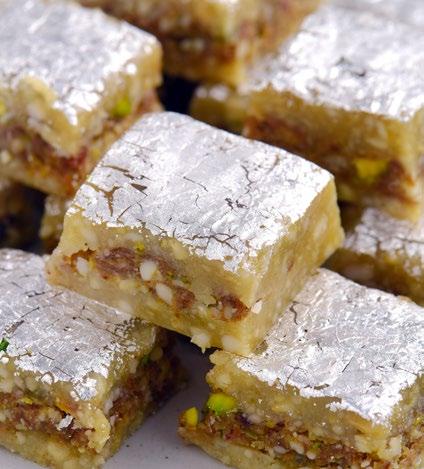
it evenly to form an even layer with a rolling pin. Let it cool for at least 1 hour to firm up.
To make the stuffing
n In a food processor, combine the mixed nuts, gulkand, and dates. Pulse until the ingredients come together into a sticky, slightly chunky paste.
n Spread this mixture on a baking sheet to spread it evenly. Keep it aside.

Assembling the Kaju Katli sandwich
n Once the cashew base has cooled, spread the nut and gulkand stuffing mixture evenly over half of it.
n Fold the other half of the cashew base over the stuffing. Press it gently to seal the layers together.
n Place the tray in the refrigerator for at least 1-2 hours to allow the kajukatli sandwich to set and firm up.
n Once set, cut the into desired shapes.
These are a naturally sweet and healthy snack, perfect for guilt-free snacking. I recommend bringing out the air fryer for these. You could cook it in the oven or on the stove, but best keep the heat low.
Ingredients
n 2/3 cup dried figs
n 1/3 cup dates, pitted
n 1 cup mixed dry fruits (cashews, almonds, pistachios)
Instructions
n Soak the dried figs in water for about an hour to soften them. Once softened, remove the tips and drain the excess water.

A fusion twist that brings together the best of ricotta cheese and the classic peda – Diwali fudge, yum.
Ingredients
n ½ kg ricotta cheese
n 1 cup milk powder
n ¾ cup sugar (adjust to 1 cup for extra sweetness)
n 3 tbsp cocoa powder
n 2 tbsp ghee
Instructions
n In a blender or food processor, combine the ricotta cheese, milk powder, sugar and cocoa powder. Blend until the mixture becomes smooth and lump-free.
n Heat a heavy-bottomed pan over low heat and add the ghee.
n Pour the blended mixture into the pan. Cook on low heat, continuously scraping the sides and stirring to prevent sticking.
n Keep cooking and stirring until the mixture becomes thick and starts to leave the sides of the pan. The consistency should be dense, but still soft enough to shape.
n Turn off the heat and transfer the mixture to a bowl to cool slightly.
n Once it’s cool enough to handle, take small portions of the mixture and roll them into smooth balls.
n Gently press the centre of each ball to flatten it slightly, giving it the traditional peda shape.
n Let the pedas cool completely before serving or storing them in an airtight container.
n In a blender or food processor, blend the figs and dates together into a thick, smooth paste. Set aside.
n Coarsely chop the mixed dry fruits (cashews, almonds, pistachios).
n In a preheated air fryer at 170 deg C, add the nuts and cook for 7-8 minutes. The nuts should turn golden and aromatic.
n Add the fig and date paste to the pan with the roasted nuts. Cook for 8-10 minutes @ 170 deg C, mix them in between the cook.
n Transfer the mixture to a tray lined with baking paper. Spread it evenly across the tray using a spatula to create a smooth, even layer.
n Allow the mixture to set in the fridge for aboutan hour, until firm.
n Once set, cut into desired shapes.
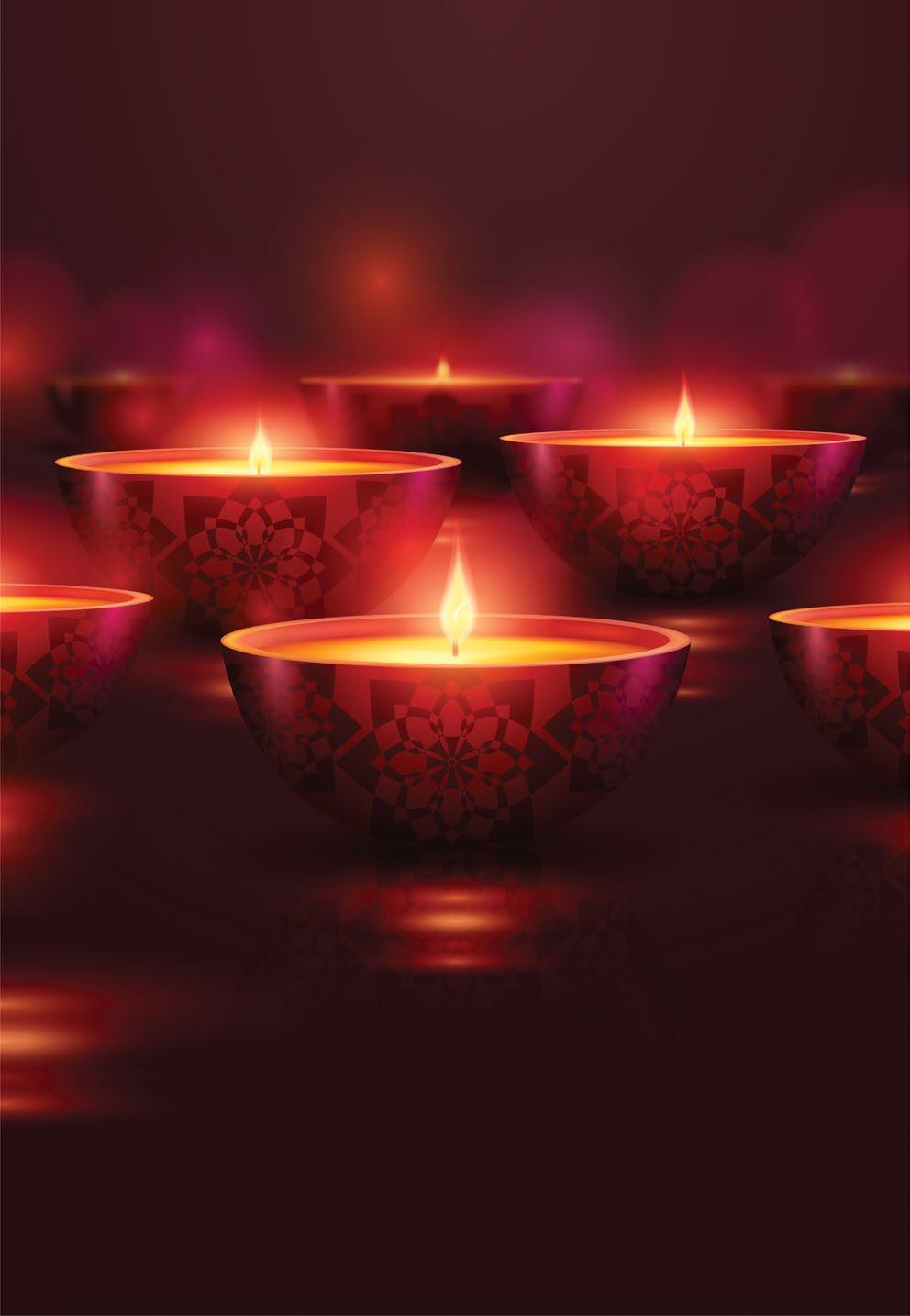
Whether you are looking to build your first home, upgrading to a new home, considering a house and land package or a knockdown and rebuild, HomeWorld is the place to go. Each Building Company has a team of experts, who are onsite to answer all of your questions and help you along the way. Visit a HomeWorld display village today to find your brand new home. HomeWorld Villages are open 7 days from 10am-5pm.
There are action and suspense thrillers, glamourous reality shows, tragic love stories, comedy, a documentary and Dharma Productions galore in NEERU SALUJA’s watchlist this month.
JIGRA (In cinemas)
There is no stopping Alia Bhatt as she takes on an intense, action-packed role in this one. She plays the role of a protective sister who is determined to save her brother (Vedang Raina) at any cost. Hopes are high for this one as it is backed by Karan Johar and Alia herself as the producers.
Releasing 11 October
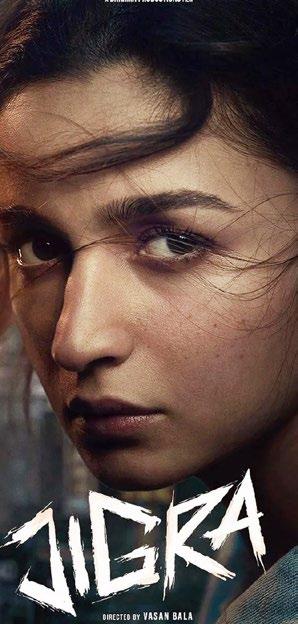
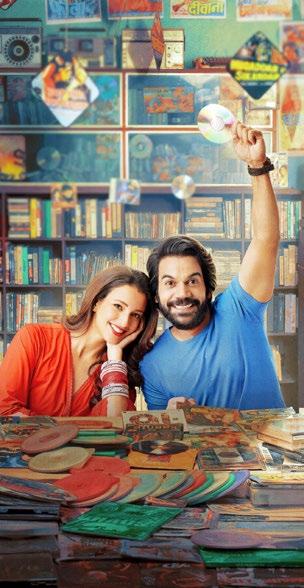
(In cinemas)
Both Rajkummar Rao and Triptii Dimri have been unstoppable this year. While the former has been receiving critical acclaim for his performances, Bhabhi number 2 is in news for her body more than her performances. Let’s see what this film promises as it tells the story of newlyweds Vicky (Rajkummar Rao) and Vidya (Triptii Dimri), whose intimate video is stolen. Releasing 11 October
Australian Indian female 5’6”/59, unmarried, beautiful, well settled, MBA, university lecturer. Seeks ideal partner, preferred medicos or highly qualified professional. Settled or willing to settle in Australia. Must be tall, handsome, well settled. Only genuine responses to 0435747736. (No SMS).Write with full bio data/photos to lataprem900@yahoo.com
Indian origin, professionally qualified, issueless match (working professional, not self-employed) from Australia, for ‘88 born 5’3" Hindu Punjabi girl (divorced, issueless), working with a government organisation in Sydney. Must have Aus PR, be a non-smoker and preferably teetotaler. Email biodata with photos, parents’ contact details to matrimonial.ml@gmail.com.
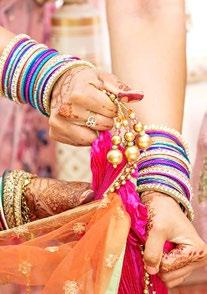
VETTAIYAN (In cinemas)
Indian cinema’s biggest stars Rajnikanth and Amitabh Bachchan reunite after their superhit Hum in this action drama which also marks the Tamil debut of Bachchan.
Releasing10 October 2024



So you just binge watched Call me Bae and Ananya Pandey and Vihaan Samat pop up again on your Netflix screen? If you are wondering what‘s happening, well, they‘re coming together again as an influencer couple in this new cyber thriller.
Releasing 4 October

The glamourous world of the Bollywood wives is in for a shake up, as three new divas from Delhi join the glitzy bandwagon. Bling vs swag, city of excess vs city of dreams, who will win the battle?!
Releasing 18 October

This crime drama starring the Dilwale sisters Kajol and Kriti Sanon tells the story of twin sisters (played by Kriti) hiding dark secrets, with a determined police inspector (Kajol) trying to solve a murder case. Sounds exciting, as both actors have rarely disappointed with their performances.
Releasing 25 October

This shocking documentary is based on a true story where the protagonist Kirat falls for a man she meets online, only to get swept up in a virtual relationship that wrecks her life for 10 years.
Releasing 18 October
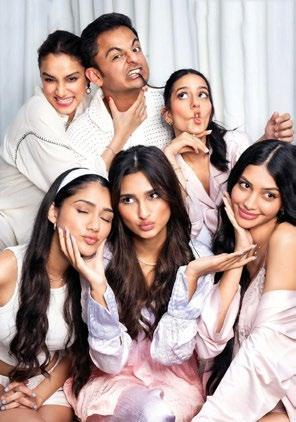
Karan Johar now follows the lives of a group of Indian influencers who chase global fame in LA. We wonder though why KJo always follows fame and glam (and the Pandey sisters)!
Releasing 4 October

Australia will finally have its own version of the highly popular comedy show The Office. Though the series is intended for an Aussie audience with references to Melbourne Cup, sausage sizzles etc – who knows, it could become a global laughing stock! Indian-origin actor Raj Labade stars in the eight-episode series.
Releasing 18 October

TABAAH (In cinemas)
Wamiqa Gabbi marked her entry into films as a leading lady in Punjabi films and now has become known nationwide with her OTT hits Jubilee and Khufiya. She now reunites with Parmish Verma in this turmoil and tragic love story, which is also directed and produced by the lead actor.
Releasing 18 October

Punjabi singer Guru Randhawa debuts as an actor in this pan-Indian film. A love story crossing borders, the film is about a Punjabi youth whose life takes an unexpected turn when he lands abroad to pursue his dreams. It goes without saying that he will also lend his voice for this movie that stars veterans Raj Babbar and Seema Kaushal.
Releasing 4 October

Jaipur newlyweds Sri and Yash reunite in Sydney after four years apart. A lot has changed since then; will they find their way back to one another? Written and created by Mithila Gupta, the series features actors Shahana Goswami and Akshay Ajit Singh, writing from Nicole Reddy and S. Shakthidharan, and music from Isha Ram Das, featuring L Fresh the Lion.
Releasing 2 October




Donate at https://www.pratham.org.au/lightalife-2024
Diwali – India’s festival of lights, is almost upon us. The lighting of lamps symbolises the victory of light over darkness, of g ood over evil, of knowledge over ignorance, of hope over despair. The light rem inds us, that while life can be difficult, there is always hope for better thing s to come.
So this Diwali, local charity Pratham Australia is calling on your generosity to donate to its #LightaLife Diwali Fundraiser in s upport of Pratham’s Second Chance program in India.
$500 will support one girl to go through the Second Chance program. All donations of $2 or more are tax deductible.

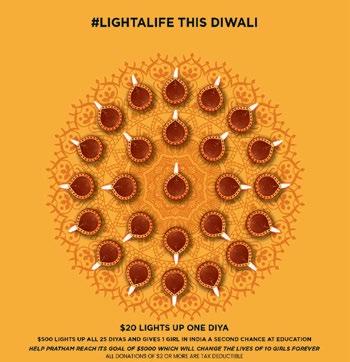
Pratham’s Second Chance program brings disadvantage d girls in India, who have had to drop out of school for reasons beyond their control, a chance to re-enter the education system and complete their secondary e ducation. This provides them with better employment and business opportunities. Their lives are improved, with benefits filtering to their children, family a nd their broader community.
Since 2011, the program has positively impacted the lives of 40,000 girls across 12 states in India.
93% of donations made to Pratham go straight to its various programs, including the Second Chance program. Pratham Australia is a v olunteer-run charity, with its support services provided on a pro-bono basis. You can follow Pratham Australia’s journey on its w ebsite (www.pratham.org.au) , Facebook, Instagram and LinkedIn.

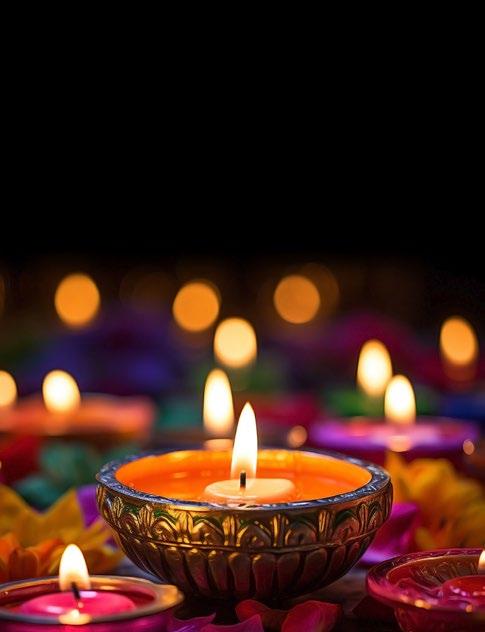


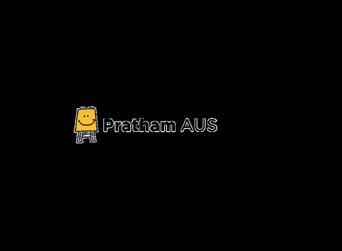
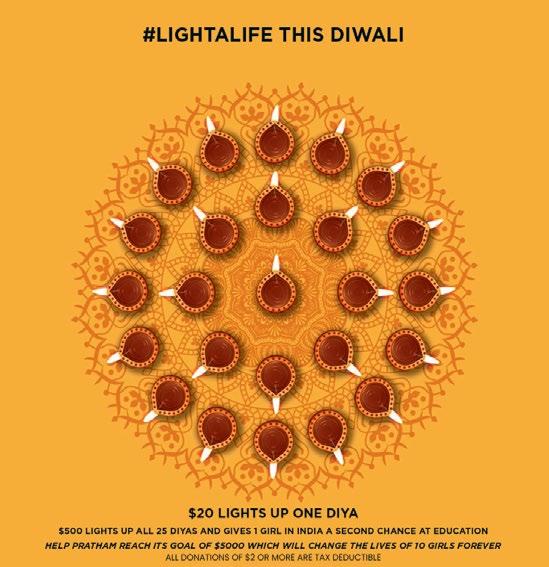




Minal Khona has been reading tarot cards for the last two decades. She uses her intuition and connect with the cards mostly to help people.
20 - MAY 20
21 - JULY 20
Aries can expect a lot of movement and action this month. Singles could meet someone they feel they have a soul connection with. Expect a pleasant surprise at work or in your business – almost like a wish being granted. Trust your intuition in legal matters. Stress could lower your energy levels. A confrontation may occur at work, but it will dissipate. Financial negotiations will go in your favour. Avoid over-analysing a situation and trust your guidance when it is time for action.
New ideas leading to more work is foretold. Singles could get swept off their feet with a new love. Thorough paperwork leads to positive outcomes. A relationship or marriage could be on the verge of a break-up. Any problems you have can be resolved by thinking them through instead of getting emotional. Finances could be a cause to worry but some of you will get a chance to expand your business. Believe in yourself and your work for best results.
A month of planning – whether it is to change your lifestyle or your job. Someone you meet by chance could lead to profits. An unexpected trip could be on the anvil. A promotion at work makes you confident and positive. Increase your intake of healthy food. The self-employed will see an increase in profits. If you have a plan in mind, someone could help you make it a reality. The thoroughness of your work is appreciated and will lead to an increase in income.
Singles may find themselves in the midst of an unusual relationship. An old flame might make a comeback. Some of you might want a short break to escape from the monotony. If getting over a trauma or heartbreak of any kind, it is time to heal your emotions. If a current relationship deepens, it could indicate marriage if both partners are inclined. An uncomfortable situation is ending. Keep pursuing your goals. If you want better relationships, strengthen your faith in God.
Leos need to pull themselves out of any rut they may have gotten into. But, if you have been in a phase where nothing interests you or are not motivated to do much, get a grip on your emotions and get back to living. The self-employed will do good business, and a new job offer could come for those looking. Avoid substance abuse during low phases. Get your act together and have faith that better times are on their way to you.
A stressful month as a loved one could get hospitalised. In a relationship, a break-up is temporary no matter how bad things seem. Money comes in through an inheritance and other avenues. Take care of your health as ignoring any issues could lead to bigger problems. A marriage could break due to egos or infidelity. Allow matters to resolve on their own. A new idea at work could lead to sizeable profits. Use every setback to grow spiritually.
Singles will be ready to date again; and those in a relationship might be thinking of living together. You will see a lot of your past efforts bring rewards this month. Avoid bingeing on food or alcohol as you will be too busy with work to undo its after-effects. A new business or reviving an old one also brings extra income. Or, a business opportunity could be profitable for the self-employed. Be confident about accepting new offers or selling your ideas.
Scorpios could become even more secretive this month. Women with reproductive health issues should seek professional help. Singles will not want to focus on a relationship right now. The selfemployed will see significant progress and an increase in finances. Trust your intuition for every big decision you need to make. Spiritually, you will do what feels right. Recognising old patterns is a good way to focus on your goals. Visualise your desired outcomes to make them a reality faster.
Singles will be busy with work and home to find time to date. A misunderstanding or sudden confrontation will prove beneficial as it makes you change direction. You have divine protection where money is concerned so even if your income fluctuates, it will keep coming in through multiple sources. An argument could lead to a falling out with a friend or boss. Others could receive an inheritance or an idea to operate differently at work. A cycle is coming to an end.
You draw the best card in the pack, so expect growth at all levels. An impromptu trip could be life-changing. Singles who’ve recently had a break-up may want to heal before dating again. Blocks at work or the inability to get a job if unemployed, are temporary. Get in touch with all your feelings if you want to feel upbeat again. Take a second opinion for a recurring medical problem. Money comes in from multiple sources. Expect some change in all aspects of your life.
The appearance of this card indicates that a sudden change is on the anvil. Short trips could keep you busy in October. Some of you may get some news or you might make a decision that will affect your income. It could be a change of job. Singles will meet someone eligible or receive a proposal. An overall feeling of positivity keeps you upbeat. Finances too take an upswing. Advancement towards personal goals is also predicted. Have faith in the Almighty.
A stressful situation will eventually turn out to be a lucky break. Avoid confrontations with family members. Your efforts don’t seem to be helping you utilise your true potential at work. All your problems will bog you down mentally so avoid focussing on them. Singles or those in a relationship could get married. If feeling exhausted, take a break. Financial losses too could occur; unexpected expenses may add to your woes. Avoid impulsive decisions and lie low till things improve on their own.
DEAR AUNTYJI
My hubby and I are both of Fiji-Indian descent, and both 46 years old. Lately my husband has been acting quite strange and I seek your guidance. He loves the Fiji type gulab jamuns and barfis and pedas. But about a month ago, he said he was going to stop eating sugar and would give up all sugary treats. Now he wasn’t doing this for health reasons - but because he said he had issues with the industrial sugar trade - and how it has caused misery to so many people in the world, including our own ancestors. Both mine and my husband’s great great grandparents were brought as slaves from India to work on cane fields - by the gore log. My husband refuses to call them indentured labourers because he insists they were slaves. I don’t disagree with him on any of this. But Auntyji, we all know that the drug of choice for us folks of Indian descent is sugar - so giving up the barfis is hard for me. How do I tell him that we can’t control what happened to our ancestors - but sugar is sugar and we need to eat it. How do I solve this peculiar problem?
AUNTYJI SAYS
My, oh my! What a wonderfully thoughtful man your husband is, and I am most impressed by his philosophy. He is quite right in that the sugar trade was essentially built off the backs of slaves from places like India and Africa. And yes - this demand for sugar led to millions of people being displaced and being forced to work as slaves. So today, when we chomp into our gulab jamuns and barfis mindlessly, without taking a moment to acknowledge that it was the demand for sugar that led to people like you and


your hubby living in Australia today- we fail to understand the price our ancestors paid. So, my little laddoo, I know it’s hard to give up the barfis and jalebis. But here is what you can do to live more mindfully - and to acknowledge the price paid by your par-dadi and par-nani and others who came to Fiji as slaves (let’s not call them indentured labourers because softening words gives legitimacy to the abhorrent practice of the slave trade). So, instead of buying sugar from the supermarket, investigate which brands of sugar are sustainably sourced. And which are not part of the industrial complex. Use this instead. And each time you have a laddoo or a peda, take a moment to thank your ancestors for their sacrifice. We all know that for the bulk of people who were taken as slaves from the motherland, their families never laid eyes on them again. Can you imagine the pain? Now imagine the sacrifice the slaves made to give better conditions to their kids - the result of which you are experiencing today. So, living mindfully is the way to go. Tell your husband that this might be a more reasonable approach. He sounds like a smart man. No need to give up the suji laddoo or the coconut barfi. Everything in moderation. Send over some barfis if you are making a batch for Diwali. Love those Fiji Indian gulab jamuns too....














SANCTUARY ELITE AURORA FACADE


The Sanctuary Elite is a prestigious home that’s been rigorously tested by families of all shapes and sizes, and always gets a thumbs up.
True to its name, the Sanctuary provides refuge from busy modern life. Upon entry, you’re drawn to the heart where you’ll find a well-appointed kitchen flowing seamlessly onto dining and leisure areas, including a home theatre.
With 5 bedrooms, 3 bathrooms, 2 garages and over 38 squares, there’s room for everyone. Downstairs features a well-appointed guest bedroom with easy access to the downstairs bathroom – perfect for visiting relatives or multi-generational living. A second living area upstairs, complete with a balcony to take in the views, means your family will have the space it needs as it grows. You can see why this is one of our most loved designs.
Take a virtual tour on our website or contact us to discuss your new home dreams.
WE DARE YOU TO COMPARE!
Scan the QR code to take the Value Check Challenge and make sure you get the best value on your new home.
Enjoy over 80 luxury upgrades INCLUDED with our Ultimate Inclusions*
// Solar PV System
// 2700mm raised ceiling height
// Fully ducted air conditioning
// Luxury Smeg appliances
// Flooring throughout
// 7-Star BASIX Package
// 40mm stone kitchen bench tops & waterfall ends
// Standard site costs & BASIX
// Monier® flat profile roof tiles or Colorbond® roofing
// Full height bathroom & ensuite wall tiles
// Freestanding bath
// And many, many more...
* Terms & Conditions apply